- Накладные расходы
- Преимущество 64-битной среды для 32-битных программ
- Перенаправления
- Почему невозможно использовать в 64-битной программе 32-битные DLL? Можно ли это обойти?
- Постепенный отказ от поддержки 32-битных программ
- Дополнительная информация
Прежде чем приступить к тематике разработки кода 64-битных программ, остановимся на вопросе обратной совместимости 64-битных версий Windows с 32-битными приложениями. Обратная совместимость осуществляется за счет механизмов, реализованных в WoW64.
WoW64 (Windows-on-Windows 64-bit) — подсистема операционной системы Windows, позволяющая запускать 32-битные приложения на всех 64-битных версиях Windows.
Подсистема WoW64 не поддерживает следующие программы:
- программы, скомпилированные для 16-разрядных операционных систем;
- программы режима ядра, скомпилированные для 32-разрядных операционных систем.
Накладные расходы
Существуют различия WoW64 в зависимости от архитектуры процессора. Например, 64-битная версия Windows разработанная для процессора Intel Itanium 2 использует WoW64 для эмуляции x86 инструкций. Такая эмуляция весьма ресурсоемка по сравнению с WoW64 для архитектуры Intel 64, так как происходит переключение с 64-битного режима в режим совместимости при выполнении 32-битных программ.
WoW64 на архитектуре Intel 64 (AMD64 / x64) не требует эмуляции инструкций. Здесь подсистема WoW64 эмулирует только 32-битное окружение за счет дополнительной прослойки между 32-битным приложением и 64-битным Windows API. Где-то эта прослойка тонкая, где-то не очень. Для средней программы потери в производительности из-за наличия такой прослойки составят около 2%. Для некоторых программ это значение может быть больше. Два процента — это немного, но следует учитывать, что 32-битные приложения работают немного медленнее под управлением 64-битной операционной системы Windows, чем в 32-битной среде.
Компиляция 64-битного кода не только исключает необходимость в WoW64, но и дает дополнительный прирост производительности. Это связано с архитектурными изменениями в микропроцессоре, такими, как увеличение количества регистров общего назначения. Для средней программы можно ожидать в пределах 5-15% прироста производительности от простой перекомпиляции.
Преимущество 64-битной среды для 32-битных программ
Из-за наличия прослойки WoW64 32-битные программы работают менее эффективно в 64-битной среде, чем в 32-битной. Но все-таки простые 32-битные приложения могут получить одно преимущество от их запуска в 64-битной среде. Вы, наверное, знаете, что программа, собранная с ключом /LARGEADDRESSAWARE:YES, может выделять до 3-х гигабайт памяти, если 32-битная операционная система Windows запущена с ключом /3gb. Так вот, эта же 32-битная программа, запущенная на 64-битной системе, может выделить почти 4 GB памяти (на практике около 3.5 GB).
Перенаправления
Подсистема WoW64 изолирует 32-разрядные программы от 64-разрядных путем перенаправления обращений к файлам и реестру. Это предотвращает случайный доступ 32-битных программ к данным 64-битных приложений. Например, 32-битное приложение, которое запускает файл DLL из каталога %systemroot%\System32, может случайно обратиться к 64-разрядному файлу DLL, который несовместим с 32-битной программой. Во избежание этого подсистема WoW64 перенаправляет доступ из папки %systemroot%\System32 в папку %systemroot%\SysWOW64. Это перенаправление позволяет предотвратить ошибки совместимости, поскольку при этом требуется файл DLL, созданный специально для работы с 32-разрядными приложениями.
Подробнее с механизмами перенаправления файловой системы и реестра можно познакомиться в разделе MSDN «Running 32-bit Applications».
Почему невозможно использовать в 64-битной программе 32-битные DLL? Можно ли это обойти?
Загрузить 32-битную DLL из 64-битного процесса и выполнить код из неё невозможно. Невозможно в силу дизайна 64-битных систем. В принципе, невозможно. Не помогут ни хитрости, ни недокументированные пути. Для этого нужно загрузить и проинициализировать WoW64, не говоря уже о структурах в ядре. Фактически нужно будет на лету превратить 64-битный процесс в 32-х битный. Подробнее эта тема рассмотрена в посте «Недокументированные функции; Загрузка 32-х битных DLL в 64-х битный процесс». Единственное, что можно порекомендовать, — это создание суррогатного процесса и взаимодействия с ним посредством технологии COM. Об этом рассказывается в статье «Accessing 32-bit DLLs from 64-bit code».
А вот загрузить ресурсы из 32-битной DLL в 64-битный процесс совсем несложно. Это можно сделать, если при вызове LoadLibraryEx указать флаг LOAD_LIBRARY_AS_DATAFILE.
Постепенный отказ от поддержки 32-битных программ
Вполне естественно, если компания Microsoft будет стимулировать переход на 64-битные системы, постепенно отказываясь от поддержки 32-битных программ в ряде версий операционной системы Windows. Конечно, это будет очень медленный процесс. Но все-таки первые шаги в этом направлении уже сделаны.
Многие администраторы знают про относительно новый режим установки и работы серверной версии операционной системы под названием Server Core. Это тот режим, о котором участники войн «Windows vs Linux» говорили очень давно. Одним из аргументов сторонников использования Linux на сервере была возможность установить серверную ОС без графического интерфейса (GUI). Но вот и в Windows Server появилась такая возможность. Установка в этом режиме позволяет получить только командную строку без пользовательского интерфейса.
Эта возможность (установка Server Core) появилась в Windows Server 2008. Но в Windows Server 2008 R2 появилось нововведение, приближающее 64-битное будущее. При установке Windows Server 2008 R2 (Server Core) поддержка запуска 32-битных приложений стала опциональной. Причем по умолчанию эта поддержка выключена. И при попытке запуска 32-битного приложения в режиме Server Core пользователь получит сообщение о невозможности запуска. Конечно, можно добавить поддержку 32-битных программ:
start /w ocsetup ServerCore-WOW64
В обычном (Full Installation) режиме 32-битные приложения по умолчанию запускаются, а вот в Server Core уже нет.
Тенденция очевидна. Со временем все более рациональным будет создание 64-битных версий приложений, так как они смогут функционировать на большем числе версий операционных систем.
Дополнительная информация
Интересным источником информации по системе WoW64 является блог Алексея Пахунова: http://blog.not-a-kernel-guy.com/. Алексей является сотрудником компании Microsoft и принимает непосредственное участие в разработке подсистемы WoW64.
Авторы курса: Андрей Карпов (karpov@viva64.com), Евгений Рыжков (evg@viva64.com).
Правообладателем курса «Уроки разработки 64-битных приложений на языке Си/Си++» является ООО «Системы программной верификации». Компания занимается разработкой программного обеспечения в области анализа исходного кода программ. Сайт компании: http://www.viva64.com.
From Wikipedia, the free encyclopedia
|
|
This article is missing information about x64 on ARM64; ARM64EC ABI (formerly ARM64X) with 1:1 register mapping to x64 calling convention. Please expand the article to include this information. Further details may exist on the talk page. (June 2021) |
WoW64
| Other names | Windows 32-bit on Windows 64-bit |
|---|---|
| Developer(s) | Microsoft |
| Initial release | October 25, 2001; 23 years ago |
| Operating system | Microsoft Windows |
| Platform | IA-64, x86-64, ARM64 |
| Type | Compatibility layer |
| License | Proprietary commercial software |
| Website | docs |
In computing on Microsoft platforms, WoW64 (Windows 32-bit on Windows 64-bit) is a subsystem of the Windows operating system capable of running 32-bit applications on 64-bit Windows.[1] It is included in all 64-bit versions of Windows, except in Windows Server Server Core where it is an optional component, and Windows Nano Server where it is not included.[a] WoW64 aims to take care of many of the differences between 32-bit Windows and 64-bit Windows, particularly involving structural changes to Windows itself.
Translation libraries
[edit]
The WoW64 subsystem comprises a lightweight compatibility layer that has similar interfaces on all 64-bit versions of Windows. It aims to create a 32-bit environment that provides the interfaces required to run unmodified 32-bit Windows applications on a 64-bit system. WOW64 is implemented using several DLLs, some of which include:[3]
Wow64.dll, the core interface to the Windows NT kernel that translates (thunks) between 32-bit and 64-bit calls, including pointer and call stack manipulationsWow64win.dll, which provides the appropriate entry-points for 32-bit applications (win32k thunks)- A dll that allows 32-bit x86 instructions to be executed, which varies by instruction set architecture.
- On x86-64,
Wow64cpu.dlltakes care of switching the processor from 32-bit to 64-bit mode. This is computationally cheap, as x86-64 machines have a native mode for running 32-bit x86 code.[4] - On IA-64 (Itanium 2), three files are needed for a slower[5] software emulation:
Wow64cpu.dll, a «CPU abstraction layer»;IA32Exec.bin, the x86 software emulator; andWowia32x.dll, the bridge between the emulator and the WOW64 system.[6] - On ARMv8 64-bit,
xtajit.dllfor x86 emulation, andwowarmhw.dllfor switching to ARM32 mode.[3]
- On x86-64,
Registry and file system
[edit]
The WoW64 subsystem also handles other key aspects of running 32-bit applications. It is involved in managing the interaction of 32-bit applications with the Windows components such as the Registry, which has distinct keys for 64-bit and 32-bit applications. For example, HKEY_LOCAL_MACHINE\Software\Wow6432Node is the 32-bit equivalent of HKEY_LOCAL_MACHINE\Software (although 32-bit applications are not aware of this redirection). Some Registry keys are mapped from 64-bit to their 32-bit equivalents, while others have their contents mirrored, depending on the edition of Windows.
The operating system uses the %SystemRoot%\system32 directory for its 64-bit library and executable files. This is done for backward compatibility reasons, as many legacy applications are hardcoded to use that path. When executing 32-bit applications, WoW64 transparently redirects access to «system32» (e.g. DLL loads) to %SystemRoot%\SysWoW64, which contains 32-bit libraries and executables. Exceptions from these redirects are:[7]
%SystemRoot%\system32\catroot%SystemRoot%\system32\catroot2%SystemRoot%\system32\driverstore(redirected on Windows Server 2008, Windows Vista, Windows Server 2003 and Windows XP)%SystemRoot%\system32\drivers\etc%SystemRoot%\system32\logfiles%SystemRoot%\system32\spool
The redirection helps to keep 32-bit applications working without them needing to be aware of the WoW64 status.[7] If a 32-bit application wants to access the real %SystemRoot%\System32, it can do so through the pseudo-directory %SystemRoot%\sysnative since Windows Vista.[7] Detection of Wow64 status is possible via IsWow64Process().
There are two Program Files directories each visible to both 32-bit and 64-bit applications. The directory that stores the 32 bit files is called Program Files (x86) to differentiate between the two, while the 64 bit maintains the traditional Program Files name without any additional qualifier. File system redirection is not used to maintain the separation; instead, WoW64 changes FOLDERID_ProgramFiles and similar query results to point installer programs to the correct directory.[8]
A few new directories are also found on ARM64, where WOW64 handles not only the running of 32-bit x86 programs, but also 32-bit ARM programs, which uses SysArm32 instead. ARM64 also supports the so-called CHPE «compiled-hybrid-PE», which has ARM64 code in a x86 dll container (for more efficient, emulation-free compatibility); these dlls are found in SyCHPE32.[9]
Application compatibility
[edit]
32-bit applications that include only 32-bit kernel-mode device drivers, or that plug into the process space of components that are implemented purely as 64-bit processes (e.g. Windows Explorer) cannot be executed on a 64-bit platform.
32-bit service applications are supported. The SysWOW64 folder located in the Windows folder on the OS drive contains several applications to support 32-bit applications (e.g. cmd.exe, odbcad32.exe, to register ODBC connections for 32-bit applications). 16-bit legacy applications for MS-DOS and early versions of Windows are usually incompatible with 64-bit versions of Windows Vista, 7, 8, and 10, but can be run on a 64-bit Windows OS via virtualization software. 32-bit versions of Windows XP, Vista, 7, 8, and 10 on the other hand, can usually run 16-bit applications with few to no problems. 16-bit applications cannot be directly run under x64 editions of Windows, because the CPU does not support VM86 mode when running in x64.
Internet Explorer is implemented as both a 32-bit and a 64-bit application because of the large number of 32-bit ActiveX components on the Internet that would not be able to plug into the 64-bit version.
Previously, the 32-bit version was used by-default and it was difficult to set the 64-bit version to be the default browser. This changed in Internet Explorer 10, which ran 32-bit add-ons inside a 64-bit session, eliminating the need to switch between the two versions. If a user was to go into the 32-bit folder (typically C:\Program Files (x86)\Internet Explorer) and double-click the iexplore.exe file there, the 64-bit version will still load. In Internet Explorer 9 and previous, this would load only the 32-bit version.
As of 2010, a bug in the translation layer of the x64 version of WoW64[10][11] also renders all 32-bit applications that rely on the Windows API function GetThreadContext incompatible. Such applications include application debuggers, call stack tracers (e.g. IDEs displaying call stack) and applications that use garbage collection (GC) engines. One of the more widely used but affected[12] GC engines is the Boehm GC. It is also used as the default garbage collector of the equally popular Mono. While Mono has introduced a new (but optional) GC as of October 2010 called SGen-GC, it performs stack scanning in the same manner as Boehm GC, thus also making it incompatible under WoW64. No fix has been provided as of July 2016, although workarounds have been suggested.[13]
According to Microsoft, 32-bit software running under WOW64 (x64) has similar performance to executing under 32-bit Windows, but with fewer threads possible. On a non-x64 system, WOW64 incurs a performance overhead due to the software emulation involved.[5]
A 32-bit application can be given a full 4 gigabytes of virtual memory on a 64-bit system, whereas on a 32-bit system, some of this addressable memory is lost because it is used by the kernel and memory-mapped peripherals such as the display adaptor, typically resulting in apps being able to use either 2GB or 3GB of RAM at most.
- Shim (computing)
- User Account Control also has a mechanism for dealing with «older» programs that write files to specific areas, on «newer» windows. Files written from a process without administrator privileges to protected locations, such as Program Files and windows\system32, will be redirected to a virtual store directory.
- Windows on Windows
- ^ Specifically:
- Windows XP Professional x64 Edition
- IA-64 and x64 versions of Windows Server 2003
- x64 versions of Windows Vista, Windows Server 2008, Windows 7, Windows 8, Windows Server 2012, Windows 8.1, Windows 10, Windows Server 2016, Windows Server 2019, Windows 11, Windows Server 2022
- ARM64 versions of Windows 10, Windows 11 and Windows Server 2022.
Wine, which is not a Microsoft product, also offers experimental WoW64 in its x64 version.[2] Wine also has
wow64.dll,wow64win.dll, andwow64cpu.dll.
- ^ QuinnRadich; DCtheGeek; msatranjr (2020-08-19). «WOW64 Implementation Details». learn.microsoft.com. Archived from the original on 2023-04-16. Retrieved 2023-04-16.
- ^ Conway, Adam (2023-01-25). «Wine 8.0 released with better controller compatibility, experimental WoW64 support, and more». XDA Developers. Archived from the original on 2023-04-16. Retrieved 2023-04-16.
- ^ a b «WOW64 Implementation Details». Microsoft. Retrieved 2018-04-21.
- ^ Eckels, Stephen (November 9, 2020). «WOW64!Hooks: WOW64 Subsystem Internals and Hooking Techniques». Mandiant.
- ^ a b «Performance and Memory Consumption Under WOW64». Microsoft. Retrieved 2013-05-06.
- ^ «WOW64 Implementation Details (Windows)». 26 April 2010. Archived from the original on 2010-04-26. – Earlier version of article, which shows
Wow64cpu.dllas part of the IA-64 implementation. - ^ a b c «File System Redirector (Windows)». msdn.microsoft.com. 2 February 2023.
- ^ «winapi — SHGetFolderPath() 32 bit vs 64 bit». Stack Overflow.
- ^ Beneš, Petr (November 4, 2018). «WoW64 internals: re-discovering Heaven’s Gate on ARM». mindless-area (wbenny.github.io).
- ^ Saw, Zach (November 13, 2010). «WOW64 bug: GetThreadContext() may return stale contents». Zach Saw’s Blog. Retrieved 2010-11-15.
- ^ «WOW64 OS bug: Old 32-bit XP apps failing under Win7 WOW64». Microsoft Developer Network. November 11, 2010. Retrieved 2010-11-15.
- ^ «Discussions about the Boehm Garbage Collector (Boehm GC)». Archived from the original on 2011-07-16. Retrieved 2010-11-25.
- ^ «GetThreadContext returns stale register values on WOW64». Microsoft= 2016-07-23. Retrieved 2016-07-23.
- MSDN page on running 32 bit apps on 64 bit Windows
Run 32-Bit Windows-Based Applications on 64-Bit Windows with WOW64#
Windows WOW64 is a subsystem of the Windows operating system that allows 32-bit applications to run on 64-bit Windows systems. WOW64 is included with all 64-bit versions of Windows and is transparent to the user, meaning that 32-bit applications will run as if they were native 64-bit applications. WOW64 provides compatibility with existing 32-bit applications and drivers, and also allows for the development of new 64-bit applications that can take advantage of the increased performance and security of 64-bit Windows. In this article we explain how WOW64 works and why it matters in fields such as Malware Analysis.
What is WoW64?#
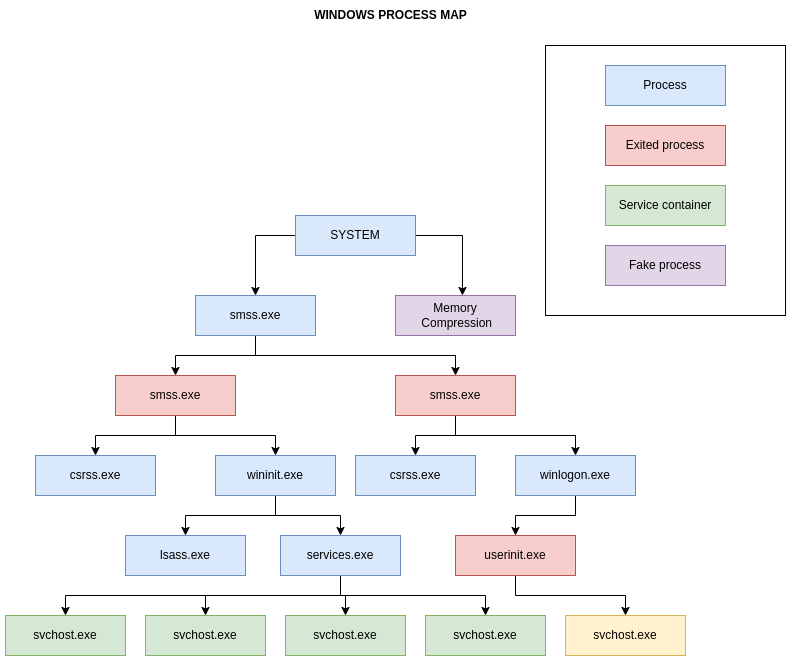
In the picture above we cover only main processes.
Windows 32-bit on Windows 64-bit, sometimes known as WoW64, is a component of the Windows operating system that allows 32-bit applications to operate on Windows 64-bit.
In other words, it is a technology that enables 32-bit applications to operate on 64-bit Windows without the application being aware that it is operating in an emulated environment.
WoW64 Main Components and Layout

As we saw in the previous layout figure, the WOW64 emulator runs in user mode. WoW64 is an interface between the 32-bit version of Ntdll.dll and the kernel of the processor, and it intercepts kernel calls.
WOW64 emulator DLLs consists of:
-
Wow64.dllis the basic emulation infrastructure and the entry-point routines forNtoskrnl.exe. -
Wow64Win.dllprovides entry-point function thunks forWin32k.sys. -
Wow64Cpu.dll(only forx64): enables the execution ofx86programs onx64.
These DLLs, along with the Ntdll.dll (64-bit version), are the only 64-bit binaries that can be loaded into a 32-bit process.
There will be two sets of Executables and DLLs on a Windows 64-bit System:
-
C:\Windows\System32-> Native64-bit -
C:\Windows\SysWoW64->32-bitimages
According to the preceding statement, native Windows 64-bit executables and DLLs can be found in the C:\Windows\System32 folder.
Consequently, cmd.exe, notepad.exe, and any other executables executing from this path are native 64-bit images.
This is an example of Notepad (32-bit) running from SysWOW64 directory:
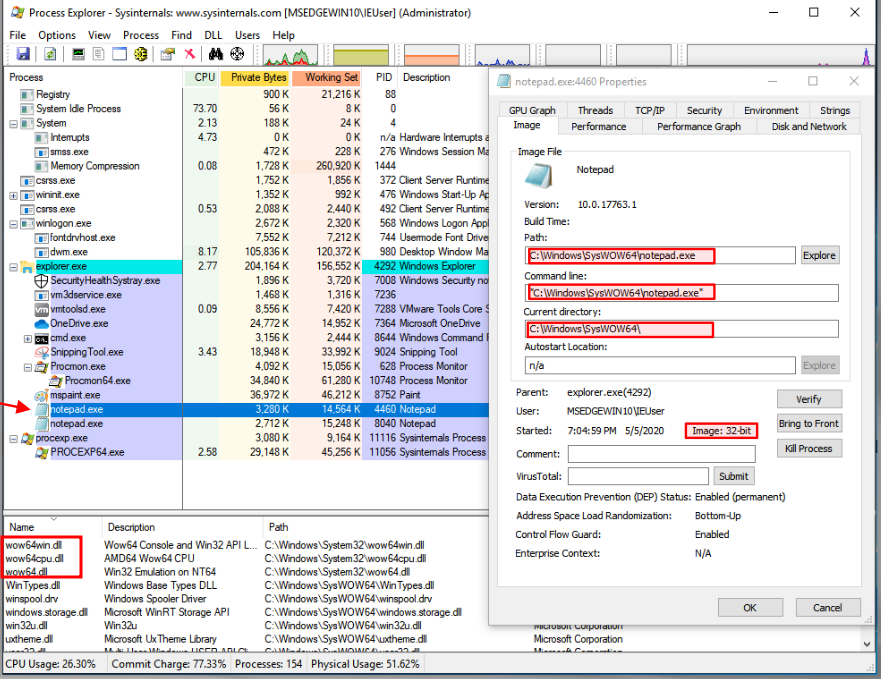
Also see the WoW64 subsystem files being loaded wow63win dll, wow64cpu.dll, and wow64.dll.
And this is Notepad (64-bit) running from System32 directory:
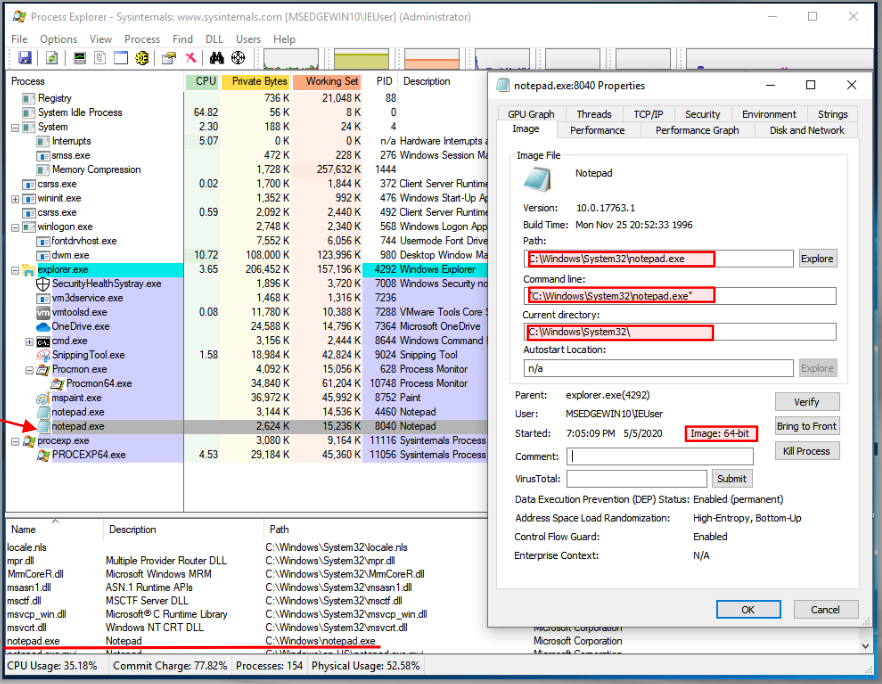
So you might be asking: Why all this redundancy in DLLs and EXEs?
This is due to the fact that 32-bit processes cannot load 64-bit DLLs, and vice versa. Also, as you recall from earlier posts, the pointer sizes and address ranges are different, which implies that without this emulation, they cannot function! The sole exception is DLLs containing only resources.
Also, if you check the 32-bit version, you will see that it has to load both the 32-bit and 64-bit version of NTDLL.dll because calls must be done using 64-bit version, so the 32-bit will pass them to the 64-bit, which is part of
how these processes work on a Windows 64-bit:
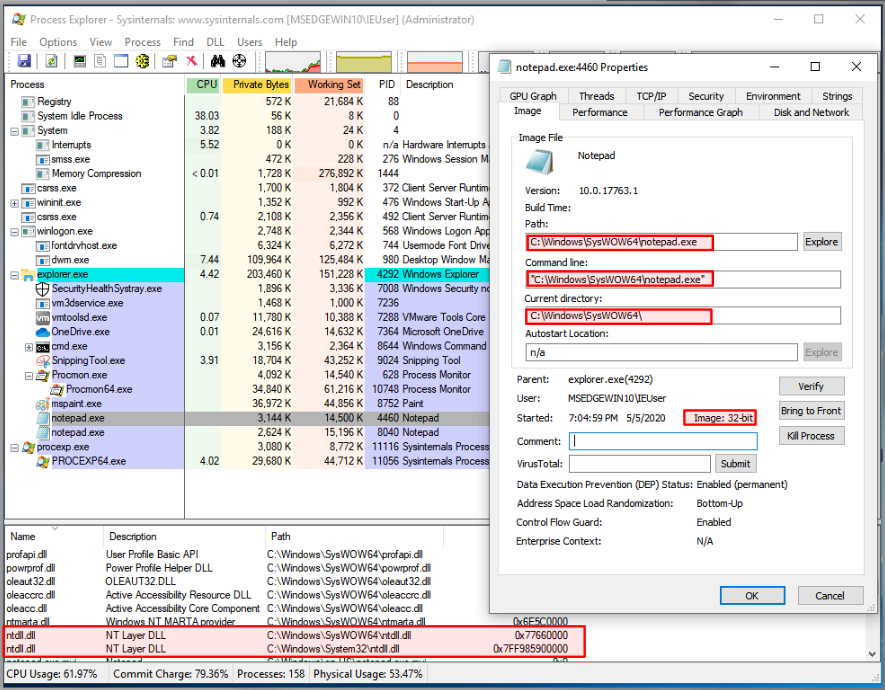
Check the addresses used for each of the NTDLL.dll pictures on the preceding image. The 32-bit version uses a 4-byte address, but the 64-bit uses an 8-byte address (8 bytes).
Note: The columns have been manually arranged to present the information you see. This is not how they are displayed by default.
WoW64 File System Redirections
WOW64 hides the fact that there is a different directory for
64-bit and 32-bit images by using a file system redirector. In most cases, whenever a 32-bit application attempts to access %windir%\System32, %windir%\lastgood\system32, or %windir%\regedit.exe, the access is redirected to an architecture-specific path.
Below is a list of examples what happens when a 32-bit x86 Process makes a request:
-
%windir%\System32(original) ->%windir%\SysWOW64— (redirected path for32-bit x86Processes) -
%windir%\lastgood\system32->%windir%\lastgood\SysWOW64 -
%windir%\cmd.exe->%windir%\SysWOW64\cmd.exe
Note: Please check the exceptions!
File redirection exceptions could happen if:
-
Access to display
UAChas special case -
Directories in the list below are also exempt from
redirection:
-
%windir%\system32\catroot -
%windir%\system32\drivers\etc -
%windir%\system32\catroot2 -
%windir%\system32\logfiles -
%windir%\system32\driverstore -
%windir%\system32\spool
But in Windows Server 2008, Windows Vista, Windows Server 2003 and Windows XP: %windir%\system32\driverstore is redirected.
Also please check the Microsoft documentation for further details.
WoW64 Registry Redirector
Similar to the file system redirector, the registry also contains a redirector to isolate 32-bit and 64-bit applications by presenting distinct logical representations of specific registry sections.
-
Registry calls are intercepted and mapped to their proper logical registry views and physical registry locations.
-
The process of redirection is transparent to the application.
Redirected keys are mapped to physical locations under Wow6432Node.
For example, HKEY_LOCAL_MACHINES\Software is moved to HKEY_LOCAL_MACHINE\Software\Wow6432Node. However, the physical position of redirected keys should be considered reserved by the system, and applications should not directly access a key’s physical location because it may change.
Why are we discussing all of this?
Well if you are monitoring a 32-bit malware sample on a Windows 64-bit system and then you see the files, libraries, and registry locations being accessed are all different than what you might expect, now you know why.
Below is a list of other core Windows System files to keep an eye out for:
-
Ntdll.dllis a DLL with a specific purpose containing internal support routines and system-service dispatch stubs to executive functions. Through a process known as system service dispatching,Ntdll.dlltransfers incoming API calls to their appropriate kernel services. -
Kernel32.dllis commonly mistaken as the Windows kernel but is actually a user-mode DLL that simply passes on requests for the kernel tontdll.dll.
Note:
Kernel32.dll,Advapi32.dll,User32.dll,Gdi32.dllare core Windows subsystem DLLs
-
Ntoskrnl.exe— Executive and kernel -
Hal.dll— HAL -
Win32k.sys— kernel-mode part of the windows subsystem (GUI) -
Hvix64.exe— Intel Hypervisor -
Hvax64.exe— AMD Hypervisor -
.sysfiles in\systeRoot\System32\Driverscore driver
files, such as DirectX, VolumeManager, TCP\IP, TPM, and
ACPI support.
What is a System Service?
You would be surprised if we say, “It’s just a process”!
A service is identical to a process, with the exception that it often runs in the background and the user may not interact with it directly! That is, this is a background process.
Conclusion#
Malware authors could make their malware run as a service, so it is also essential to comprehend how it operates and how it is often configured. This topic will be discussed in greater depth in a subsequent post about “persistence mechanisms.”
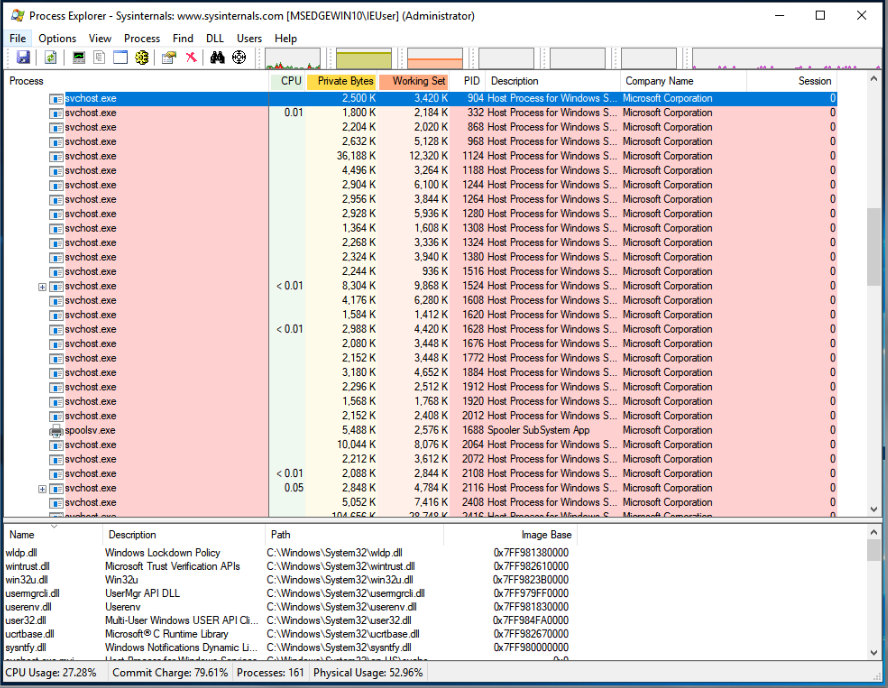
Yes, all of them are Windows services operating in the background. There is no specific count for them, but they are numerous!
References#
WoW64 Implementation Details
Filesystem Redirector
Registry Redirector
WoW64 (Windows-on-Windows 64-bit) is a subsystem of Windows allowing you to launch 32-bit applications on all the 64-bit Windows versions. Launching of obsolete 16-bit applications on 64-bit Windows systems is impossible.
Wow64 subsystem emulates 32-bit environment with the help of an additional layer between a 32-bit application and 64-bit Windows API. In some places this layer is rather thin and in others it is not. For an average program presence of this layer will cause performance loss of about 2%. For some programs it can be greater. 2% is not much but you should take into account that 32-bit applications operate much slower under a 64-bit version of Windows operation system than under a 32-bit one.
Compilation of 64-bit code does not only exclude the necessity of WoW64 but also provides an additional performance gain. It is explained by architectural alterations within the microprocessor such as increase of the number of common-purpose registers. For an average program you can expect a 5-15% performance gain after simple recompilation of the program.
An additional performance gain can be achieved when using 64-bit data types. Viva64 static code analyzer can help you here. Although its main purpose is searching errors in 64-bit code, still you can increase a program’s operation rate following its recommendations.
References
- Wikipedia. WOW64.
- Blog of Alexey Pahunov who is Microsoft’s worker and who participates in development of WoW64 subsystem
- Optimization of 64-bit programs
- Development of Resource-intensive Applications in Visual C++
- 64-bit Lessons. Lesson 2. Support of 32-bit applications in the 64-bit Windows environment.
We can email you a selection of our best articles once a month
WoW64 — aka Windows (32-bit) on Windows (64-bit) — is a subsystem that enables
32-bit Windows applications to run on 64-bit Windows. Most people today are
familiar with WoW64 on Windows x64, where they can run x86 applications.
WoW64 has been with us since Windows XP, and x64 wasn’t the only architecture
where WoW64 has been available — it was available on IA-64 architecture as
well, where WoW64 has been responsible for emulating x86. Newly, WoW64 is also
available on ARM64, enabling emulation of both x86 and ARM32
appllications.
MSDN offers brief article on WoW64 implementation details.
We can find that WoW64 consists of (ignoring IA-64):
- Translation support DLLs:
wow64.dll: translation ofNt*system calls (ntoskrnl.exe/ntdll.dll)wow64win.dll: translation ofNtGdi*,NtUser*and other GUI-related
system calls (win32k.sys/win32u.dll)
- Emulation support DLLs:
wow64cpu.dll: support for running x86 programs on x64wowarmhw.dll: support for running ARM32 programs on ARM64xtajit.dll: support for running x86 programs on ARM64
Besides Nt* system call translation, the wow64.dll provides the core
emulation infrastructure.
If you have previous experience with reversing WoW64 on x64, you can notice
that it shares plenty of common code with WoW64 subsystem on ARM64. Especially
if you peeked into WoW64 of recent x64 Windows, you may have noticed that it
actually contains strings such as SysArm32 and that some functions check
against IMAGE_FILE_MACHINE_ARMNT (0x1C4) machine type:
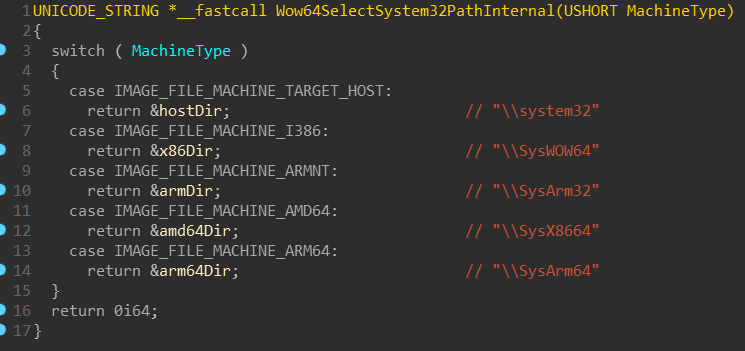

WoW on x64 systems cannot emulate ARM32 though — it just apparently shares
common code. But SysX8664 and SysArm64 sound particularly interesting!
Those similarities can help anyone who is fluent in x86/x64, but not that much
in ARM. Also, HexRays decompiler produce much better output for x86/x64 than
for ARM32/ARM64.
Initially, my purpose with this blogpost was to get you familiar with how WoW64
works for ARM32 programs on ARM64. But because WoW64 itself changed a lot with
Windows 10, and because WoW64 shares some similarities between x64 and ARM64,
I decided to briefly get you through how WoW64 works in general.
Everything presented in this article is based on Windows 10 — insider preview,
build 18247.
Table of contents
- Terms
- Kernel
- Kernel (initialization)
- Kernel (create process)
- Initialization of the WoW64 process
wow64!ProcessInitwow64!ServiceTableswow64!Wow64SystemServiceEx
wow64!ProcessInit(cont.)wow64!ThreadInit
- x86 on x64
- Entering 32-bit mode
- Leaving 32-bit mode
- Turbo thunks
- Disabling Turbo thunks
- x86 on ARM64
Windows\SyCHPE32&Windows\SysWOW64
- ARM32 on ARM64
nt!KiEnter32BitMode/SVC 0xFFFFnt!KiExit32BitMode/UND #0xF8
- Appendix
Terms
Througout this article I’ll be using some terms I’d like to explain beforehand:
ntdllorntdll.dll— these will be always refering to the nativentdll.dll(x64 on Windows x64, ARM64
on Windows ARM64, …), until said otherwise or until the context wouldn’t indicate otherwise.ntdll32orntdll32.dll— to make an easy distinction between native and
WoW64ntdll.dll, any WoW64ntdll.dllwill be refered with the*32suffix.emuoremu.dll— these will represent any of the emulation support DLLs (one ofwow64cpu.dll,
wowarmhw.dll,xtajit.dll)module!FunctionName— refers to a symbolFunctionNamewithin themodule.
If you’re familiar with WinDbg, you’re already familiar with this notation.CHPE— “compiled-hybrid-PE”, a new type of PE file, which looks as if it was x86
PE file, but has ARM64 code within them.CHPEwill be tackled in more detail
in the x86 on ARM64 section.- The terms emulation and binary-translation refer to the WoW64 workings
and they may be used interchangeably.
Kernel
This section shows some points of interest in the ntoskrnl.exe regarding to
the WoW64 initialization. If you’re interested only in the user-mode part of
the WoW64, you can skip this part to the
Initialization of the WoW64 process.
Kernel (initialization)
Initalization of WoW64 begins with the initialization of the kernel:
nt!KiSystemStartupnt!KiInitializeKernelnt!InitBootProcessornt!PspInitPhase0nt!Phase1Initializationnt!IoInitSystemnt!IoInitSystemPreDriversnt!PsLocateSystemDlls
nt!PsLocateSystemDlls routine takes a pointer named nt!PspSystemDlls,
and then calls nt!PspLocateSystemDll in a loop. Let’s figure out what’s
going on here:


nt!PspSystemDlls appears to be array of pointers to some structure, which
holds some NTDLL-related data. The order of these NTDLLs corresponds with
this enum (included in the PDB):
Now, let’s look how such structure looks like:
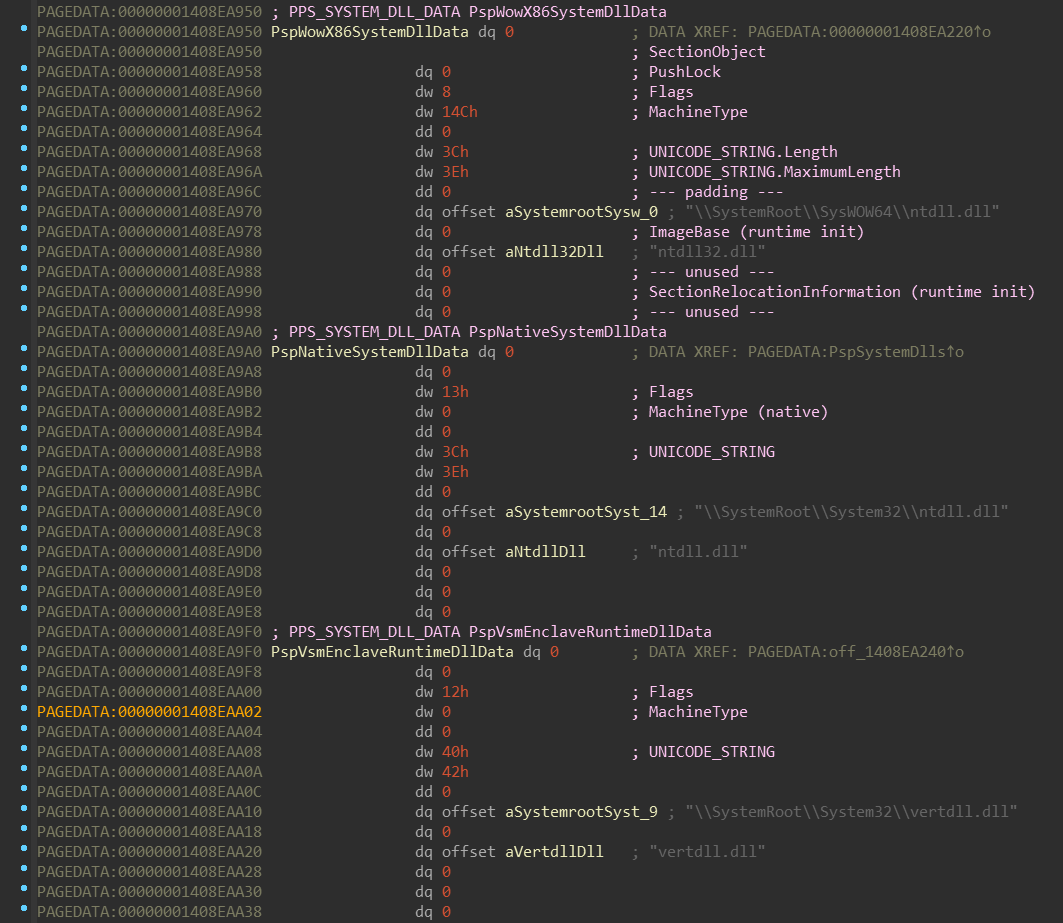
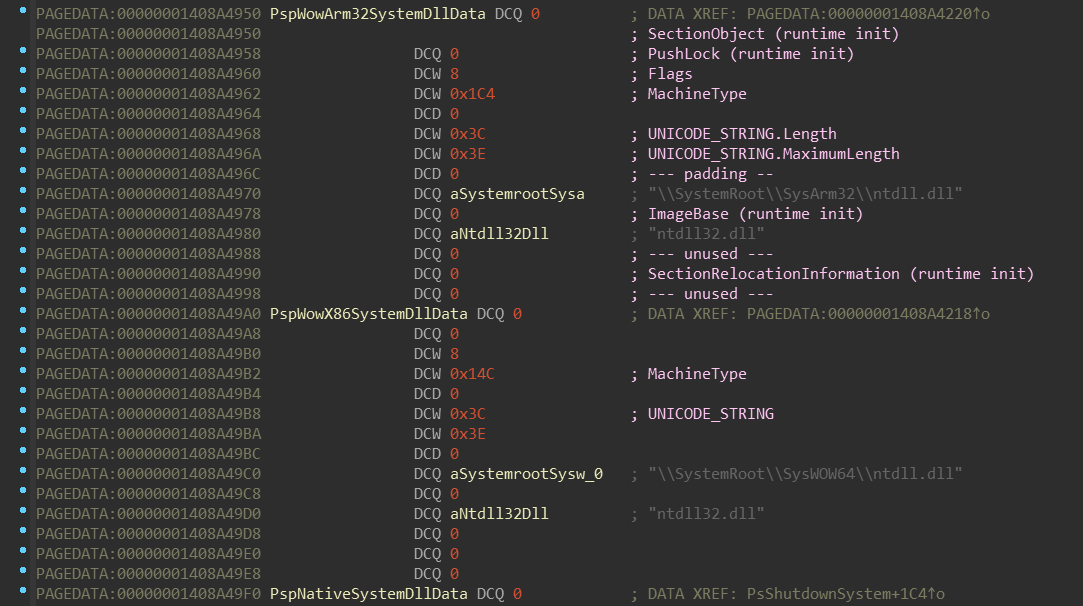
The nt!PspLocateSystemDll function intializes fields of this structure. The
layout of this structure isn’t unfortunatelly in the PDB, but you can
find a reconstructed version in the appendix.
Now let’s get back to the nt!Phase1Initialization — there’s more:
...nt!Phase1Initializationnt!Phase1InitializationIoReadynt!PspInitPhase2nt!PspInitializeSystemDlls
nt!PspInitializeSystemDlls routine takes a pointer named nt!NtdllExportInformation.
Let’s look at it:


It looks like it’s some sort of array, again, ordered by the enum _SYSTEM_DLL_TYPE.
Let’s examine NtdllExports:
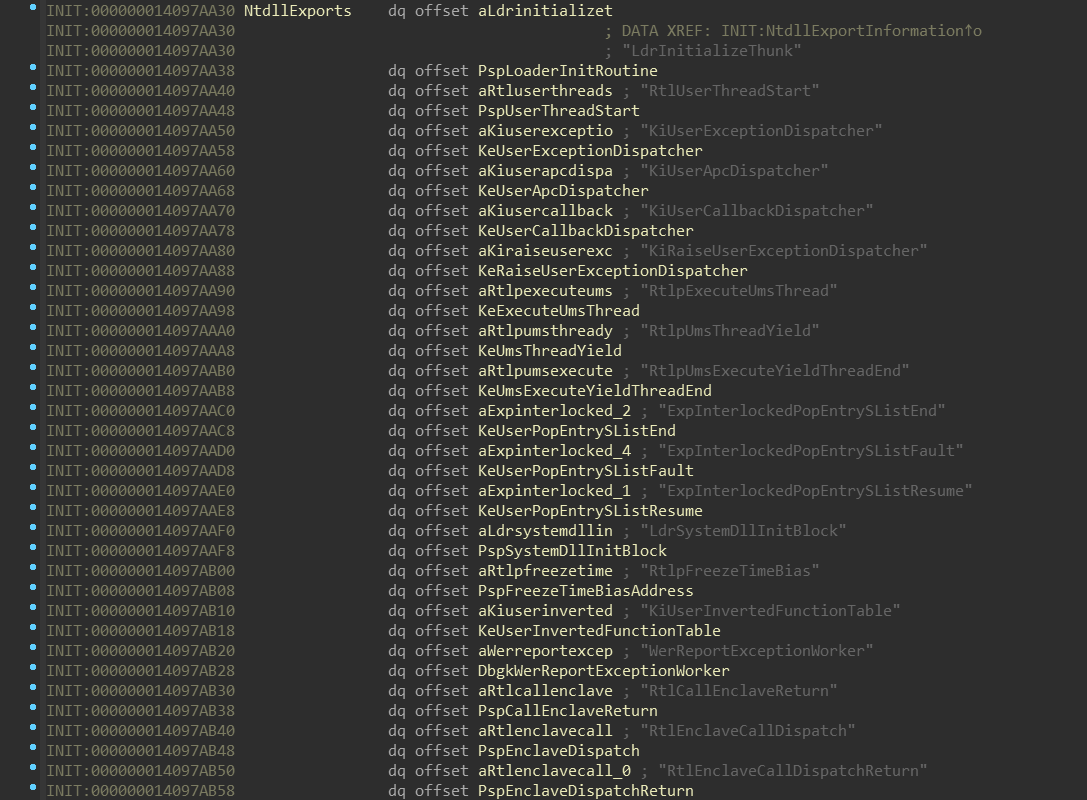
Nothing unexpected — just tuples of function name and function pointer.
Did you notice the difference in the number after the NtdllExports field? On x64
there is 19 meanwhile on ARM64 there is 14. This number represents number
of items in NtdllExports — and indeed, there is slightly different set of them:
| x64 | ARM64 |
|---|---|
(0) LdrInitializeThunk |
(0) LdrInitializeThunk |
(1) RtlUserThreadStart |
(1) RtlUserThreadStart |
(2) KiUserExceptionDispatcher |
(2) KiUserExceptionDispatcher |
(3) KiUserApcDispatcher |
(3) KiUserApcDispatcher |
(4) KiUserCallbackDispatcher |
(4) KiUserCallbackDispatcher |
| — | (5) KiUserCallbackDispatcherReturn |
(5) KiRaiseUserExceptionDispatcher |
(6) KiRaiseUserExceptionDispatcher |
(6) RtlpExecuteUmsThread |
— |
(7) RtlpUmsThreadYield |
— |
(8) RtlpUmsExecuteYieldThreadEnd |
— |
(9) ExpInterlockedPopEntrySListEnd |
(7) ExpInterlockedPopEntrySListEnd |
(10) ExpInterlockedPopEntrySListFault |
(8) ExpInterlockedPopEntrySListFault |
(11) ExpInterlockedPopEntrySListResume |
(9) ExpInterlockedPopEntrySListResume |
(12) LdrSystemDllInitBlock |
(10) LdrSystemDllInitBlock |
(13) RtlpFreezeTimeBias |
(11) RtlpFreezeTimeBias |
(14) KiUserInvertedFunctionTable |
(12) KiUserInvertedFunctionTable |
(15) WerReportExceptionWorker |
(13) WerReportExceptionWorker |
(16) RtlCallEnclaveReturn |
— |
(17) RtlEnclaveCallDispatch |
— |
(18) RtlEnclaveCallDispatchReturn |
— |
We can see that ARM64 is missing Ums (User-Mode Scheduling) and
Enclave functions. Also, we can see that ARM64 has one
extra function: KiUserCallbackDispatcherReturn.
On the other hand, all NtdllWow*Exports contain the same set of function names:
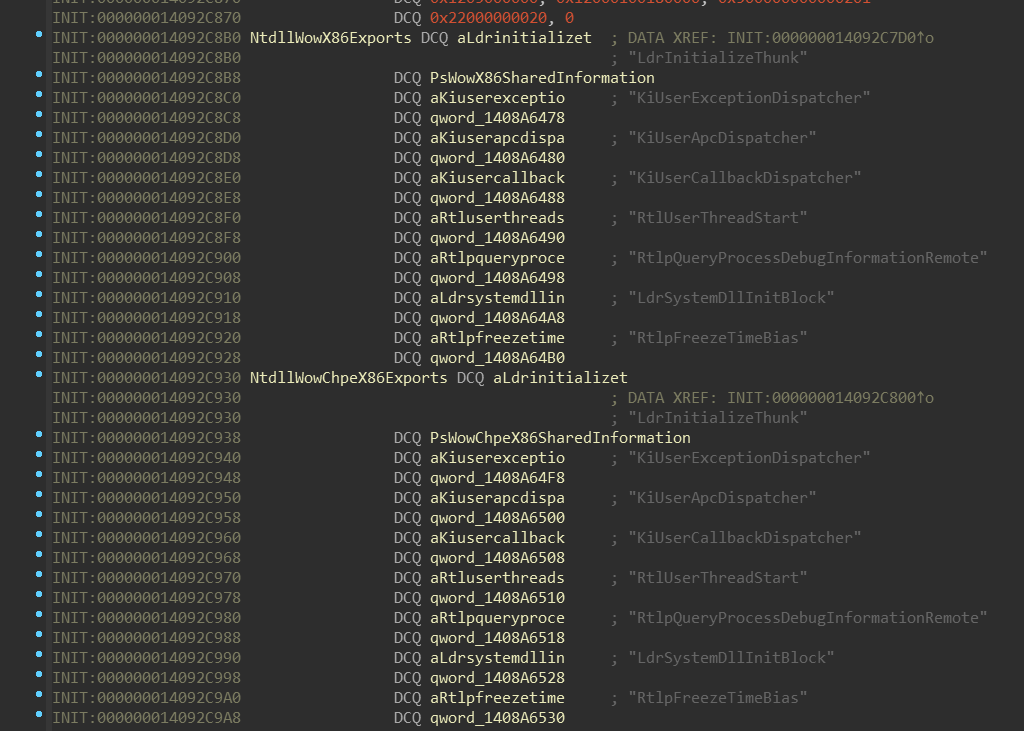
Notice names of second fields of these “structures”: PsWowX86SharedInformation,
PsWowChpeX86SharedInformation, … If we look at the address of those fields,
we can see that they’re part of another array:

Those addresses are actually targets of the pointers in the NtdllWow*Exports
structure. Also, those functions combined with PsWow*SharedInformation might
give you hint that they’re related to this enum (included in the PDB):
Notice how the order of the SharedNtdll32BaseAddress corellates with the empty field in
the previous screenshot (highlighted). The set of WoW64 NTDLL functions is same
on both x64 and ARM64.
(The C representation of this data can be found in the appendix.)
Now we can tell what the nt!PspInitializeSystemDlls function does — it gets
image base of each NTDLL (nt!PsQuerySystemDllInfo), resolves all
Ntdll*Exports for them (nt!RtlFindExportedRoutineByName). Also, only for
all WoW64 NTDLLs (if ((SYSTEM_DLL_TYPE)SystemDllType > PsNativeSystemDll))
it assigns the image base to the SharedNtdll32BaseAddress field of the
PsWow*SharedInformation array (nt!PspWow64GetSharedInformation).
Kernel (create process)
Let’s talk briefly about process creation. As you probably already know, the
native ntdll.dll is mapped as a first DLL into each created process. This
applies for all architectures — x86, x64 and also for ARM64.
The WoW64 processes aren’t exception to this rule — the WoW64 processes share
the same initialization code path as native processes.
nt!NtCreateUserProcessnt!PspAllocateProcessnt!PspSetupUserProcessAddressSpacent!PspPrepareSystemDllInitBlocknt!PspWow64SetupUserProcessAddressSpace
nt!PspAllocateThreadnt!PspWow64InitThreadnt!KeInitThread // Entry-point: nt!PspUserThreadStartup
nt!PspUserThreadStartupnt!PspInitializeThunkContextnt!KiDispatchException
If you ever wondered how is the first user-mode instruction of the newly created
process executed, now you know the answer — a “synthetic” user-mode exception
is dispatched, with ExceptionRecord.ExceptionAddress = &PspLoaderInitRoutine,
where PspLoaderInitRoutine points to the ntdll!LdrInitializeThunk.
This is the first function that is executed in every process — including WoW64
processes.
Initialization of the WoW64 process
The fun part begins!
NOTE: Initialization of the
wow64.dllis same on both x64 and ARM64.
Eventual differences will be mentioned.
ntdll!LdrInitializeThunkntdll!LdrpInitializentdll!_LdrpInitializentdll!LdrpInitializeProcessntdll!LdrpLoadWow64
The ntdll!LdrpLoadWow64 function is called when the ntdll!UseWOW64 global variable is TRUE,
which is set when NtCurrentTeb()->WowTebOffset != NULL.
It constructs the full path to the wow64.dll, loads it, and then resolves
following functions:
Wow64LdrpInitializeWow64PrepareForExceptionWow64ApcRoutineWow64PrepareForDebuggerAttachWow64SuspendLocalThread
NOTE: The resolution of these pointers is wrapped between pair of
ntdll!LdrProtectMrdatacalls, responsible for protecting (1) and
unprotecting (0) the.mrdatasection — in which these pointers reside.
MRDATA(Mutable Read Only Data) are part of the CFG (Control-Flow Guard)
functionality. You can look at Alex’s slides for more
information.
When these functions are successfully located, the ntdll.dll finally
transfers control to the wow64.dll by calling wow64!Wow64LdrpInitialize.
Let’s go through the sequence of calls that eventually bring us to the entry-point
of the “emulated” application.
wow64!Wow64LdrpInitializewow64!Wow64InfoPtr = (NtCurrentPeb32() + 1)NtCurrentTeb()->TlsSlots[/* 10 */ WOW64_TLS_WOW64INFO] = wow64!Wow64InfoPtrntdll!RtlWow64GetCpuAreaInfowow64!ProcessInitwow64!CpuNotifyMapViewOfSection // Process imagewow64!Wow64DetectMachineTypeInternalwow64!Wow64SelectSystem32PathInternalwow64!CpuNotifyMapViewOfSection // 32-bit NTDLL imagewow64!ThreadInitwow64!ThunkStartupContext64TO32wow64!Wow64SetupInitialCallwow64!RunCpuSimulationemu!BTCpuSimulate
Wow64InfoPtr is the first initialized variable in the wow64.dll. It contains
data shared between 32-bit and 64-bit execution mode and its structure is not
documented, although you can find this structure partialy restored in the appendix.
RtlWow64GetCpuAreaInfo is an internal ntdll.dll function which is called a lot
during emulation. It is mainly used for fetching the machine type and architecture-specific
CPU context (the CONTEXT structure) of the emulated process. This information is fetched into an undocumented
structure, which we’ll be calling WOW64_CPU_AREA_INFO. Pointer to this structure
is then given to the ProcessInit function.
Wow64DetectMachineTypeInternal determines the machine type of the executed
process and returns it. Wow64SelectSystem32PathInternal selects the “emulated”
System32 directory based on that machine type, e.g. SysWOW64 for x86 processes
or SysArm32 for ARM32 processes.
You can also notice calls to CpuNotifyMapViewOfSection function. As the name
suggests, it is also called on each “emulated” call of NtMapViewOfSection.
This function:
- Checks if the mapped image is executable
- Checks if following conditions are true:
NtHeaders->OptionalHeader.MajorSubsystemVersion == USER_SHARED_DATA.NtMajorVersionNtHeaders->OptionalHeader.MinorSubsystemVersion == USER_SHARED_DATA.NtMinorVersion
If these checks pass, CpupResolveReverseImports function is called. This function
checks if the mapped image exports the Wow64Transition symbol and if so, it
assigns there a 32-bit pointer value returned by emu!BTCpuGetBopCode.
The Wow64Transition is mostly known to be exported by SysWOW64\ntdll.dll,
but there are actually multiple of Windows’ WoW DLLs which exports this symbol.
You might be already familiar with the term “Heaven’s Gate” —
this is where the Wow64Transition will point to on Windows x64 — a simple far
jump instruction which switches into long-mode (64-bit) enabled code segment.
On ARM64, the Wow64Transition points to a “nop” function.
NOTE: Because there are no checks on the
ImageName, theWow64Transition
symbol is resolved for all executable images that passes the checks mentioned
earlier. If you’re wondering whetherWow64Transitionwould be resolved for
your custom executable or DLL — it indeed would!
The initialization then continues with thread-specific initialization by
calling ThreadInit. This is followed by pair of calls
ThunkStartupContext64TO32(CpuArea.MachineType, CpuArea.Context, NativeContext)
and Wow64SetupInitialCall(&CpuArea) — these functions perform the necessary
setup of the architecture-specific WoW64 CONTEXT structure to prepare start
of the execution in the emulated environment. This is done in the exact same
way as if ntoskrnl.exe would actually executed the emulated application — i.e.:
- setting the instruction pointer to the address of
ntdll32!LdrInitializeThunk - setting the stack pointer below the WoW64
CONTEXTstructure - setting the 1st parameter to point to that
CONTEXTstructure - setting the 2nd parameter to point to the base address of the
ntdll32
Finally, the RunCpuSimulation function is called. This function just
calls BTCpuSimulate from the binary-translator DLL, which contains the
actual emulation loop that never returns.
wow64!ProcessInit
wow64!Wow64ProtectMrdata // 0wow64!Wow64pLoadLogDllntdll!LdrLoadDll // "%SystemRoot%\system32\wow64log.dll"
wow64.dll has also it’s own .mrdata section and ProcessInit begins with
unprotecting it. It then tries to load the wow64log.dll from the constructed
system directory. Note that this DLL is never present in any released Windows
installation (it’s probably used internally by Microsoft for debugging of the
WoW64 subsystem). Therefore, load of this DLL will normally fail. This isn’t
problem, though, because no critical functionality of the WoW64 subsystem
depends on it. If the load would actually succeed, the wow64.dll would try
to find following exported functions there:
Wow64LogInitializeWow64LogSystemServiceWow64LogMessageArgListWow64LogTerminate
If any of these functions wouldn’t be exported, the DLL would be immediately
unloaded.
If we’d drop custom wow64log.dll (which would export functions mentioned above)
into the %SystemRoot%\System32 directory, it would actually get loaded into
every WoW64 process. This way we could drop a custom logging DLL, or even inject
every WoW64 process with native DLL!
For more details, you can check my injdrv project which implements
injection of native DLLs into WoW64 processes, or check this post by Walied Assar.
Then, certain important values are fetched from the LdrSystemDllInitBlock array.
These contains base address of the ntdll32.dll, pointer to functions like
ntdll32!KiUserExceptionDispatcher, ntdll32!KiUserApcDispatcher, …,
control flow guard information and others.
Finally, the Wow64pInitializeFilePathRedirection is called, which — as the name
suggests — initializes WoW64 path redirection. The path redirection is completely
implemented in the wow64.dll and the mechanism is basically based on string
replacement. The path redirection can be disabled and enabled by calling
kernel32!Wow64DisableWow64FsRedirection & kernel32!Wow64RevertWow64FsRedirection
function pairs. Both of these functions internally call ntdll32!RtlWow64EnableFsRedirectionEx,
which directly operates on NtCurrentTeb()->TlsSlots[/* 8 */ WOW64_TLS_FILESYSREDIR] field.
wow64!ServiceTables
Next, a ServiceTables array is initialized. You might be already familiar
with the KSERVICE_TABLE_DESCRIPTOR from the ntoskrnl.exe, which contains — among
other things — a pointer to an array of system functions callable from the user-mode.
ntoskrnl.exe contains 2 of these tables: one for ntoskrnl.exe itself and one
for the win32k.sys, aka the Windows (GUI) subsystem. wow64.dll has 4 of them!
The WOW64_SERVICE_TABLE_DESCRIPTOR has the exact same structure as the KSERVICE_TABLE_DESCRIPTOR,
except that it is extended:
(More detailed definition of this structure is in the appendix.)
ServiceTables array is populated as follows:
ServiceTables[/* 0 */ WOW64_NTDLL_SERVICE_INDEX] = sdwhnt32ServiceTables[/* 1 */ WOW64_WIN32U_SERVICE_INDEX] = wow64win!sdwhwin32ServiceTables[/* 2 */ WOW64_KERNEL32_SERVICE_INDEX = wow64win!sdwhconServiceTables[/* 3 */ WOW64_USER32_SERVICE_INDEX] = sdwhbase
NOTE:
wow64.dlldirectly depends (by import table) on two DLLs:
the nativentdll.dllandwow64win.dll. This means thatwow64win.dllis
loaded even into “non-Windows-subsystem” processes, that wouldn’t normally
loaduser32.dll.These two symbols mentioned above are the only symbols that
wow64.dllrequires
wow64win.dllto export.
Let’s have a look at sdwhnt32 service table:

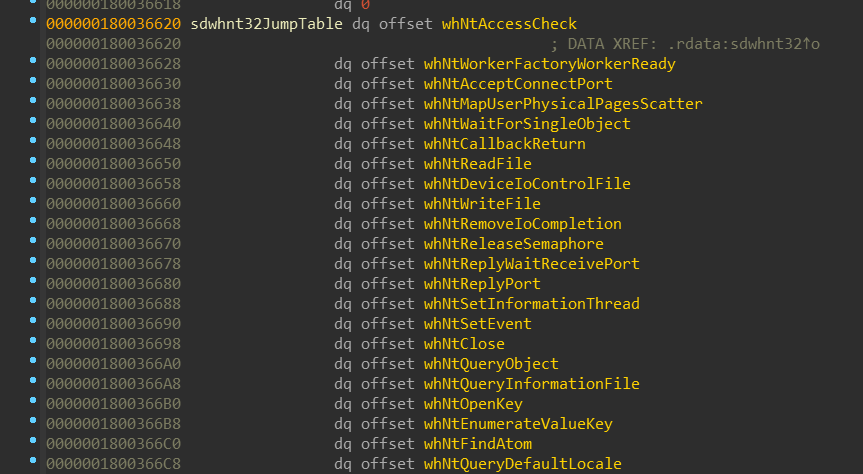
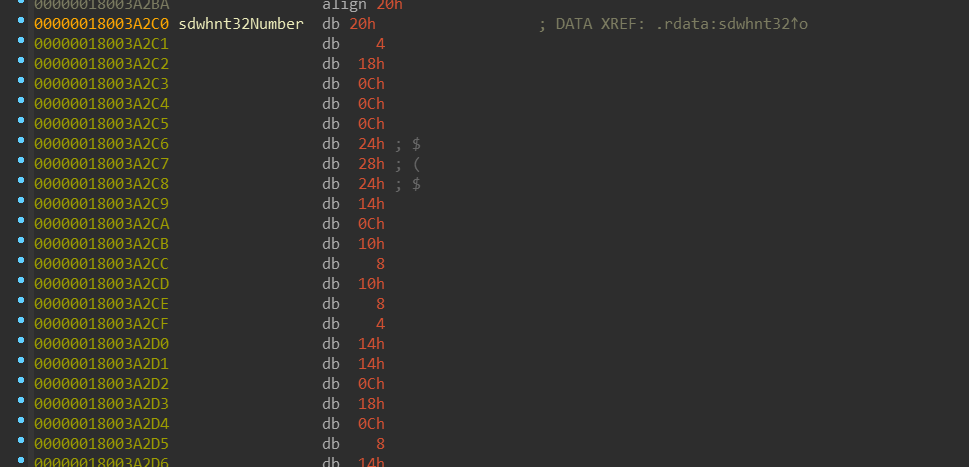
There is nothing surprising for those who already dealt with service tables in ntoskrnl.exe.
sdwhnt32JumpTable contains array of the system call functions, which are
traditionaly prefixed. WoW64 “system calls” are prefixed with wh*, which
honestly I don’t have any idea what it stands for — although it might be the
case as with Zw* prefix — it stands for nothing and is simply used as an
unique distinguisher.
The job of these wh* functions is to correctly convert any arguments and
return values from the 32-bit version to the native, 64-bit version. Keep in
mind that that it not only includes conversion of integers and pointers, but
also content of the structures. Interesting note might be that each of the
wh* functions has only one argument, which is pointer to an array of 32-bit
values. This array contains the parameters passed to the 32-bit system call.
As you could notice, in those 4 service tables there are “system calls” that
are not present in the ntoskrnl.exe. Also, I mentioned earlier that the
Wow64Transition is resolved in multiple DLLs. Currently, these DLLs export
this symbol:
ntdll.dllwin32u.dllkernel32.dllandkernelbase.dlluser32.dll
The ntdll.dll and win32u.dll are obvious and they represent the same thing
as their native counterparts. The service tables used by kernel32.dll and
user32.dll contain functions for transformation of particular csrss.exe calls
into their 64-bit version.
It’s also worth noting that at the end of the ntdll.dll system table, there
are several functions with NtWow64* calls, such as NtWow64ReadVirtualMemory64,
NtWow64WriteVirtualMemory64 and others. These are special functions which are
provided only to WoW64 processes.
One of these special functions is also NtWow64CallFunction64. It has it’s own
small dispatch table and callers can select which function should be called
based on its index:

NOTE: I’ll be talking about one of these functions — namely
Wow64CallFunctionTurboThunkControl—
later in the Disabling Turbo thunks section.
wow64!Wow64SystemServiceEx
This function is similar to the kernel’s nt!KiSystemCall64 — it does the
dispatching of the system call. This function is exported by the wow64.dll
and imported by the emulation DLLs. Wow64SystemServiceEx accepts 2 arguments:
- The system call number
- Pointer to an array of 32-bit arguments passed to the system call (mentioned earlier)
The system call number isn’t just an index, but also contains index of a system
table which needs to be selected (this is also true for ntoskrnl.exe):
This function then selects ServiceTables[ServiceTableIndex] and calls the
appropriate wh* function based on the SystemCallNumber.
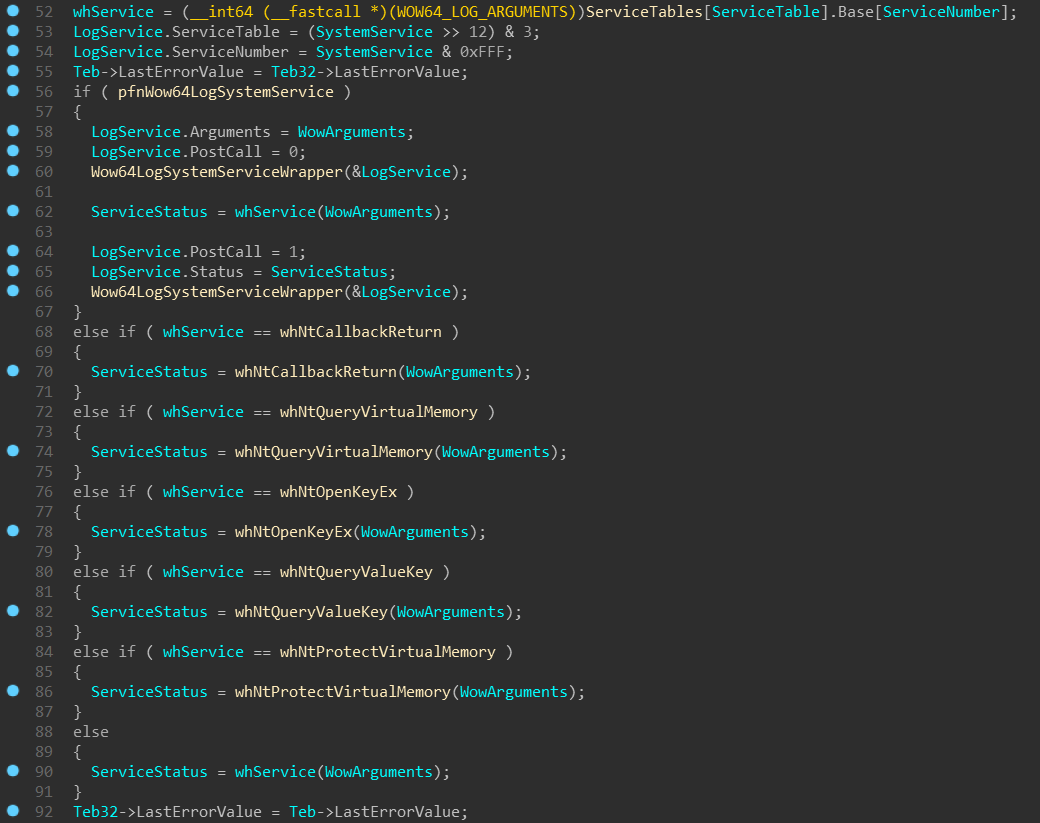
NOTE: In case the
wow64log.dllhas been successfully loaded, theWow64SystemServiceEx
function callsWow64LogSystemServiceWrapper(wrapper aroundwow64log!Wow64LogSystemService
function): once before the actual system call and one immediately after. This
can be used for instrumentation of each WoW64 system call! The structure
passed toWow64LogSystemServicecontains every important information about
the system call — it’s table index, system call number, the argument list and
on the second call, even the resultingNTSTATUS! You can find layout of
this structure in the appendix (WOW64_LOG_SERVICE).
Finally, as have been mentioned, the WOW64_SERVICE_TABLE_DESCRIPTOR structure
differs from KSERVICE_TABLE_DESCRIPTOR in that it contains ErrorCase table.
The code mentioned above is actually wrapped in a SEH __try/__except
block. If whService raise an exception, the __except block calls
Wow64HandleSystemServiceError function. The function looks if the corresponding
service table which raised the exception has non-NULL ErrorCase and if it does,
it selects the appropriate WOW64_ERROR_CASE for the system call. If the ErrorCase
is NULL, the values from ErrorCaseDefault are used. The NTSTATUS of the
exception is then transformed according to an algorithm which can be found in the appendix.
wow64!ProcessInit (cont.)
...wow64!CpuLoadBinaryTranslator // MachineTypewow64!CpuGetBinaryTranslatorPath // MachineTypentdll!NtOpenKey // "\Registry\Machine\Software\Microsoft\Wow64\"ntdll!NtQueryValueKey // "arm" / "x86"ntdll!RtlGetNtSystemRoot // "arm" / "x86"ntdll!RtlUnicodeStringPrintf // "%ws\system32\%ws"
As you’ve probably guessed, this function constructs path to the binary-translator DLL,
which is — on x64 — known as wow64cpu.dll. This DLL will be responsible for
the actual low-level emulation.



We can see that there is no wow64cpu.dll on ARM64. Instead, there is xtajit.dll
used for x86 emulation and wowarmhw.dll used for ARM32 emulation.
NOTE: The
CpuGetBinaryTranslatorPathfunction is same on both x64 and
ARM64 except for one peculiar difference:
on Windows x64, if the\Registry\Machine\Software\Microsoft\Wow64\x86key cannot
be opened (is missing/was deleted), the function contains a fallback to load
wow64cpu.dll. On Windows ARM64, though, it doesn’t have such fallback and if
the registry key is missing, the function fails and the WoW64 process is terminated.
wow64.dll then loads one of the selected DLL and tries to find there following
exported functions:
BTCpuProcessInit (!) |
BTCpuProcessTerm |
BTCpuThreadInit |
BTCpuThreadTerm |
BTCpuSimulate (!) |
BTCpuResetFloatingPoint |
BTCpuResetToConsistentState |
BTCpuNotifyDllLoad |
BTCpuNotifyDllUnload |
BTCpuPrepareForDebuggerAttach |
BTCpuNotifyBeforeFork |
BTCpuNotifyAfterFork |
BTCpuNotifyAffinityChange |
BTCpuSuspendLocalThread |
BTCpuIsProcessorFeaturePresent |
BTCpuGetBopCode (!) |
BTCpuGetContext |
BTCpuSetContext |
BTCpuTurboThunkControl |
BTCpuNotifyMemoryAlloc |
BTCpuNotifyMemoryFree |
BTCpuNotifyMemoryProtect |
BTCpuFlushInstructionCache2 |
BTCpuNotifyMapViewOfSection |
BTCpuNotifyUnmapViewOfSection |
BTCpuUpdateProcessorInformation |
BTCpuNotifyReadFile |
BTCpuCfgDispatchControl |
BTCpuUseChpeFile |
BTCpuOptimizeChpeImportThunks |
BTCpuNotifyProcessExecuteFlagsChange |
BTCpuProcessDebugEvent |
BTCpuFlushInstructionCacheHeavy |
Interestingly, not all functions need to be found — only those marked with the
“(!)”, the rest is optional. As a next step, the resolved BTCpuProcessInit
function is called, which performs binary-translator-specific process initialization.
At the end of the ProcessInit function, wow64!Wow64ProtectMrdata(1) is called,
making .mrdata non-writable again.
wow64!ThreadInit
wow64!ThreadInitwow64!CpuThreadInitNtCurrentTeb32()->WOW32Reserved = BTCpuGetBopCode()emu!BTCpuThreadInit
ThreadInit does some little thread-specific initialization, such as:
- Copying
CurrentLocaleandIdealProcessorvalues from 64-bitTEBinto
32-bitTEB. - For non-
WOW64_CPUFLAGS_SOFTWAREemulators, it callsCpuThreadInit, which:- Performs
NtCurrentTeb32()->WOW32Reserved = BTCpuGetBopCode(). - Calls
emu!BTCpuThreadInit().
- Performs
- For
WOW64_CPUFLAGS_SOFTWAREemulators, it creates an event, which added into
AlertByThreadIdEventHashTableand set toNtCurrentTeb()->TlsSlots[18].
This event is used for special emulation ofNtAlertThreadByThreadIdand
NtWaitForAlertByThreadId.
NOTE: The
WOW64_CPUFLAGS_MSFT64 (1)or theWOW64_CPUFLAGS_SOFTWARE (2)
flag is stored in theNtCurrentTeb()->TlsSlots[/* 10 */ WOW64_TLS_WOW64INFO],
in theWOW64INFO.CpuFlagsfield. One of these flags is always set in the
emulator’sBTCpuProcessInitfunction (mentioned in the section above):
wow64cpu.dllsetsWOW64_CPUFLAGS_MSFT64 (1)wowarmhw.dllsetsWOW64_CPUFLAGS_MSFT64 (1)xtajit.dllsetsWOW64_CPUFLAGS_SOFTWARE (2)
x86 on x64
Entering 32-bit mode
...wow64!RunCpuSimulationwow64cpu!BTCpuSimulatewow64cpu!RunSimulatedCode
RunSimulatedCode runs in a loop and performs transitions into 32-bit mode
either via:
jmp fword ptr[reg]— a “far jump” that not only changes instruction pointer (RIP),
but also the code segment register (CS). This segment usually being set to0x23,
while 64-bit code segment is0x33- synthetic “machine frame” and
iret— called on every “state reset”
NOTE: Explanation of segmentation and “why does it work just by changing
a segment register” is beyond scope of this article. If you’d like to know more about
“long mode” and segmentation, you can start here.
Far jump is used most of the time for the transition, mainly because it’s faster.
iret on the other hand is more powerful, as it can change CS, SS, EFLAGS, RSP and RIP
all at once. The “state reset” occurs when WOW64_CPURESERVED.Flags has
WOW64_CPURESERVED_FLAG_RESET_STATE (1) bit set. This happens during exception
(see wow64!Wow64PrepareForException and wow64cpu!BTCpuResetToConsistentState).
Also, this flag is cleared on every emulation loop (using btr — bit-test-and-reset).
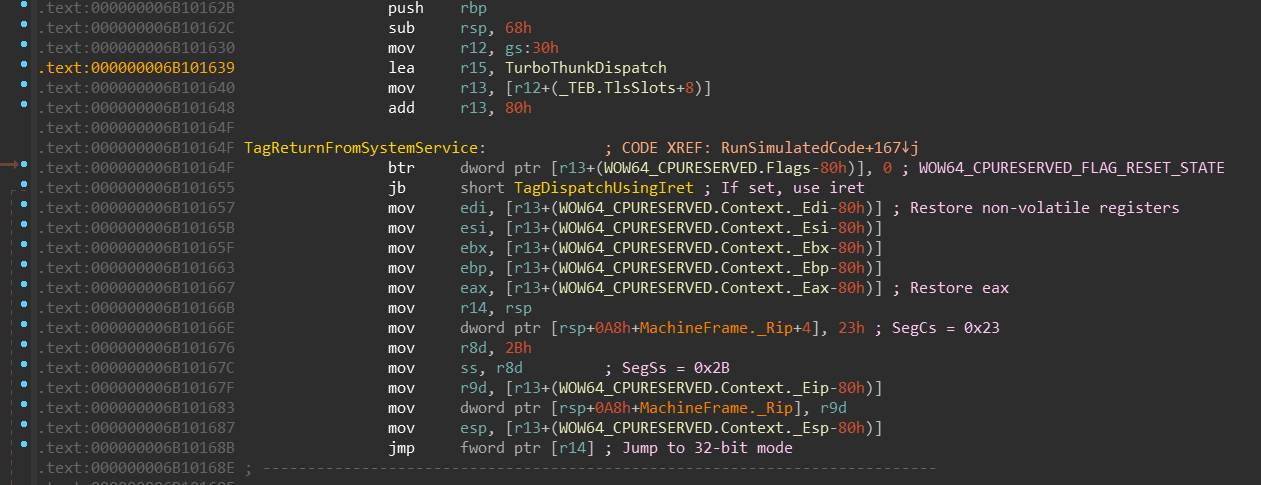
You can see the simplest form of switching into the 32-bit mode. Also, at the beginning
you can see that TurboThunkDispatch address is moved into the r15 register.
This register stays untouched during the whole RunSimulatedCode function.
Leaving 32-bit mode
The switch back to the 64-bit mode is very similar — it also uses far jumps.
The usual situation when code wants to switch back to the 64-bit mode is upon
system call:

The Wow64SystemServiceCall is just a simple jump to the Wow64Transition:

If you remember, the Wow64Transition value is resolved by the wow64cpu!BTCpuGetBopCode
function:

It selects either KiFastSystemCall or KiFastSystemCall2 based on the CpupSystemCallFast
value.
The KiFastSystemCall looks like this (used when CpupSystemCallFast != 0):
[x86] jmp 33h:$+9(jumps to the instruction below)[x64] jmp qword ptr [r15+offset](which points toCpupReturnFromSimulatedCode)
The KiFastSystemCall2 looks like this (used when CpupSystemCallFast == 0):
[x86] push 0x33[x86] push eax[x86] call $+5[x86] pop eax[x86] add eax, 12[x86] xchg eax, dword ptr [esp][x86] jmp fword ptr [esp](jumps to the instruction below)[x64] add rsp, 8[x64] jmp wow64cpu!CpupReturnFromSimulatedCode
Clearly, the KiFastSystemCall is faster, so why it’s not used used every time?
It turns out, CpupSystemCallFast is set to 1 in the wow64cpu!BTCpuProcessInit function if
the process is not executed with the ProhibitDynamicCode mitigation policy
and if NtProtectVirtualMemory(&KiFastSystemCall, PAGE_READ_EXECUTE) succeeds.
This is because KiFastSystemCall is in a non-executable read-only section (W64SVC) while
KiFastSystemCall2 is in read-executable section (WOW64SVC).
But the actual reason why is KiFastSystemCall in non-executable section by default and needs to be
set as executable manually is, honestly, unknown to me. My guess would be that
it has something to do with relocations, because the address in the jmp 33h:$+9
instruction must be somehow resolved by the loader. But maybe I’m wrong. Let me know if you know the answer!
Turbo thunks
I hope you didn’t forget about the TurboThunkDispatch address hanging in the
r15 register. This value is used as a jump-table:
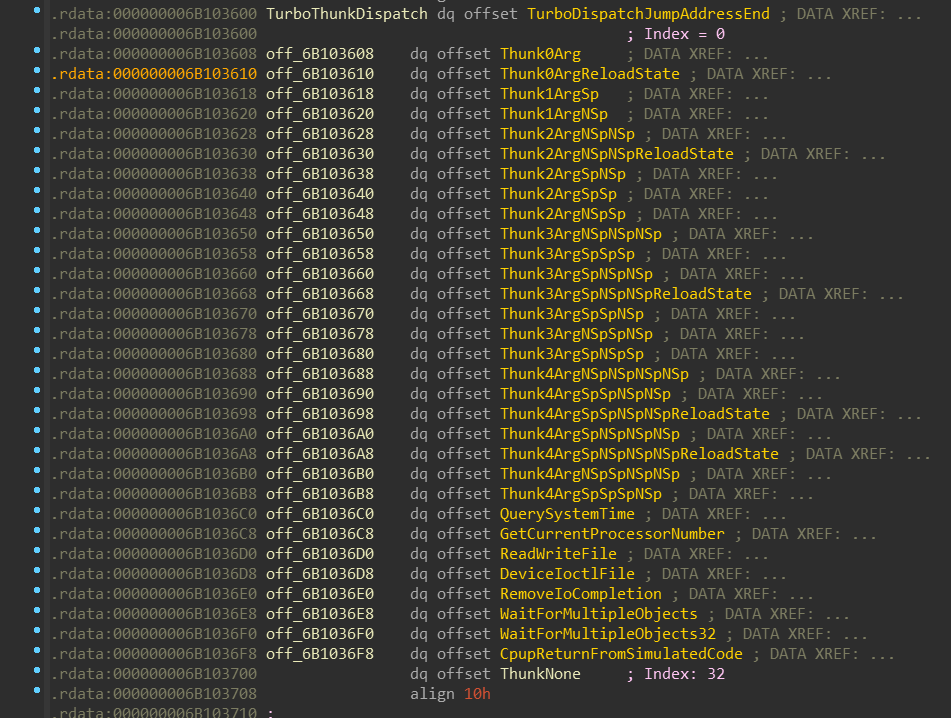
There are 32 items in the jump-table.
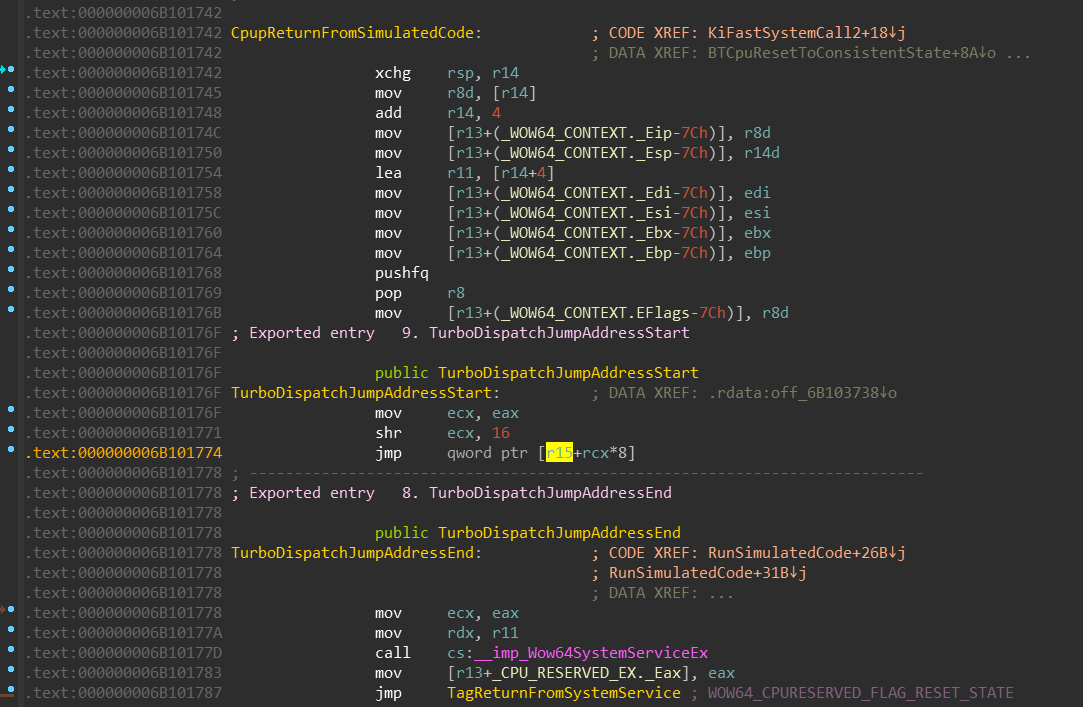
CpupReturnFromSimulatedCode is the first code that is always executed in the 64-bit
mode when 32-bit to 64-bit transition occurs. Let’s recapitulate the code:
- Stack is swapped,
- Non-volatile registers are saved
eax— which contains the encoded service table index and system call number —
is moved into theecx- it’s high-word is acquired via
ecx >> 16. - the result is used as an index into the
TurboThunkDispatchjump-table
You might be confused now, because few sections above we’ve defined the service
number like this:
…therefore, after right-shifting this value by 16 bits we should get always 0,
right?
It turns out, on x64, the WOW64_SYSTEM_SERVICE might be defined like this:
Let’s examine few WoW64 system calls:



Based on our new definition of WOW64_SYSTEM_SERVICE, we can conclude that:
NtMapViewOfSectionuses turbo thunk with index 0 (TurboDispatchJumpAddressEnd)NtWaitForSingleObjectuses turbo thunk with index 13 (Thunk3ArgSpNSpNSpReloadState)NtDeviceIoControlFileuses turbo thunk with index 27 (DeviceIoctlFile)
Let’s finally explain “turbo thunks” in proper way.
Turbo thunks are an optimalization of WoW64 subsystem — specifically on Windows x64 —
that enables for particular system calls to never leave the wow64cpu.dll — the
conversion of parameters and return value, and the syscall instruction itself
is fully performed there. The set of functions that use these turbo thunks reveals,
that they are usually very simple in terms of parameter conversion — they receive
numerical values or handles.
The notation of Thunk* labels is as follows:
- The number specifies how many arguments the function receives
Spconverts parameter with sign-extensionNSpconverts parameter without sign-extensionReloadStatewill return to the 32-bit mode usingiretinstead of far jump,
ifWOW64_CPURESERVED_FLAG_RESET_STATEis setQuerySystemTime,ReadWriteFile,DeviceIoctlFile, … are special cases
Let’s take the NtWaitForSingleObject and its turbo thunk Thunk3ArgSpNSpNSpReloadState
as an example:
- it receives 3 parameters
- 1st parameter is sign-extended
- 2nd parameter isn’t sign-extended
- 3rd parameter isn’t sign-extended
- it can switch to 32-bit mode using
iretifWOW64_CPURESERVED_FLAG_RESET_STATEis set
When we cross-check this information with its function prototype, it makes sense:
The sign-extension of HANDLE makes sense, because if we pass there an INVALID_HANDLE_VALUE,
which happens to be 0xFFFFFFFF (-1) on 32-bits, we don’t want to convert this value
to 0x00000000FFFFFFFF, but 0xFFFFFFFFFFFFFFFF.
On the other hand, if the TurboThunkNumber is 0, the call will end up in the
TurboDispatchJumpAddressEnd which in turn calls wow64!Wow64SystemServiceEx.
You can consider this case as the “slow path”.
Disabling Turbo thunks
On Windows x64, the Turbo thunk optimization can be actually disabled!
In one of
the previous sections I’ve been talking about ntdll32!NtWow64CallFunction64 and
wow64!Wow64CallFunctionTurboThunkControl functions. As with any other NtWow64*
function, NtWow64CallFunction64 is only available in the WoW64 ntdll.dll.
This function can be called with an index to WoW64 function in the
Wow64FunctionDispatch64 table (mentioned earlier).
The function prototype might look like this:
NOTE: This function prototype has been reconstructed with the help of the
wow64!Wow64CallFunction64Nopfunction code, which just logs the parameters.
We can see that wow64!Wow64CallFunctionTurboThunkControl can be called with an
index of 2. This function performs some sanity checks and then passes calls
wow64cpu!BTCpuTurboThunkControl(*(ULONG*)InputBuffer).
wow64cpu!BTCpuTurboThunkControl then checks the input parameter.
- If it’s 0, it patches every target of the jump table to point to
TurboDispatchJumpAddressEnd(remember, this is the target that is called when
WOW64_SYSTEM_SERVICE.TurboThunkNumberis 0). - If it’s non-0, it returns
STATUS_NOT_SUPPORTED.
This means 2 things:
- Calling
wow64cpu!BTCpuTurboThunkControl(0)disables the Turbo thunks, and
every system call ends up taking the “slow path”. - It is not possible to enable them back.
With all this in mind, we can achieve disabling Turbo thunks by this call:
What it might be good for? I can think of 3 possible use-cases:
-
If we deploy custom
wow64log.dll, disabling Turbo thunks
guarantees that we will see every WoW64 system call in our
wow64log!Wow64LogSystemServicecallback. We wouldn’t see such calls if the Turbo thunks
were enabled, because they would take the “fast path” inside of thewow64cpu.dll
where thesyscallwould be executed. -
If we decide to hook
Nt*functions in the nativentdll.dll, disabling
Turbo thunks guarantees that for eachNt*function called in thentdll32.dll,
the correspondintNt*function will be called in the nativentdll.dll.
(This is basically the same point as the previous one.)NOTE: Keep in mind that this only applies on system calls, i.e. on
Nt*
orZw*functions. Other functions are not called from the 32-bitntdll.dll
to the 64-bitntdll.dll. For example, if we hookedRtlDecompressBuffer
in the nativentdll.dllof the WoW64 process, it wouldn’t be called
onntdll32!RtlDecompressBuffercall. This is because the full implementaion of the
Rtl*functions is already in thentdll32.dll. -
We can “harmlessly” patch high-word moved to the
eaxin every WoW64 system call stub to 0.
For example we could see inNtWaitForSingleObjectthere ismov eax, 0D0004h.
If we patched appropriate 2 bytes in that instruction so that the instruction
would becomemov eax, 4h, the system call would still work.This approach can be used as an anti-hooking technique — if there’s a jump
at the start of the function, the patch will break it. If there’s not a jump,
we just disable the Turbo thunk for this function.
x86 on ARM64
Emulation of x86 applications on ARM64 is handled by an actual binary translation.
Instead of wow64cpu.dll, the xtajit.dll (probably shortcut for “x86 to ARM64 JIT”)
is used for its emulation. As with other emulation DLLs, this DLL is native (ARM64).
The x86 emulation on Windows ARM64 consists also of other “XTA” components:
xtac.exe— XTA CompilerXtaCache.exe— XTA Cache Service
Execution of x86 programs on ARM64 appears to go way behind just emulation. It
is also capable of caching already binary-translated code, so that next execution
of the same application should be faster. This cache is located in the Windows\XtaCache
directory which contains files in format FILENAME.EXT.HASH1.HASH2.mp.N.jc.
These files are then mapped to the user-mode address space of the application.
If you’re asking whether you can find an actual ARM64 code in these files — indeed,
you can.
Unfortunatelly, Microsoft doesn’t provide symbols to any of these xta* DLLs or executables. But if
you’re feeling adventurous, you can find some interesting artifacts, like
this array of structures inside of the xtajit.dll, which contains name of the function and its pointer.
There are thousands of items in this array:
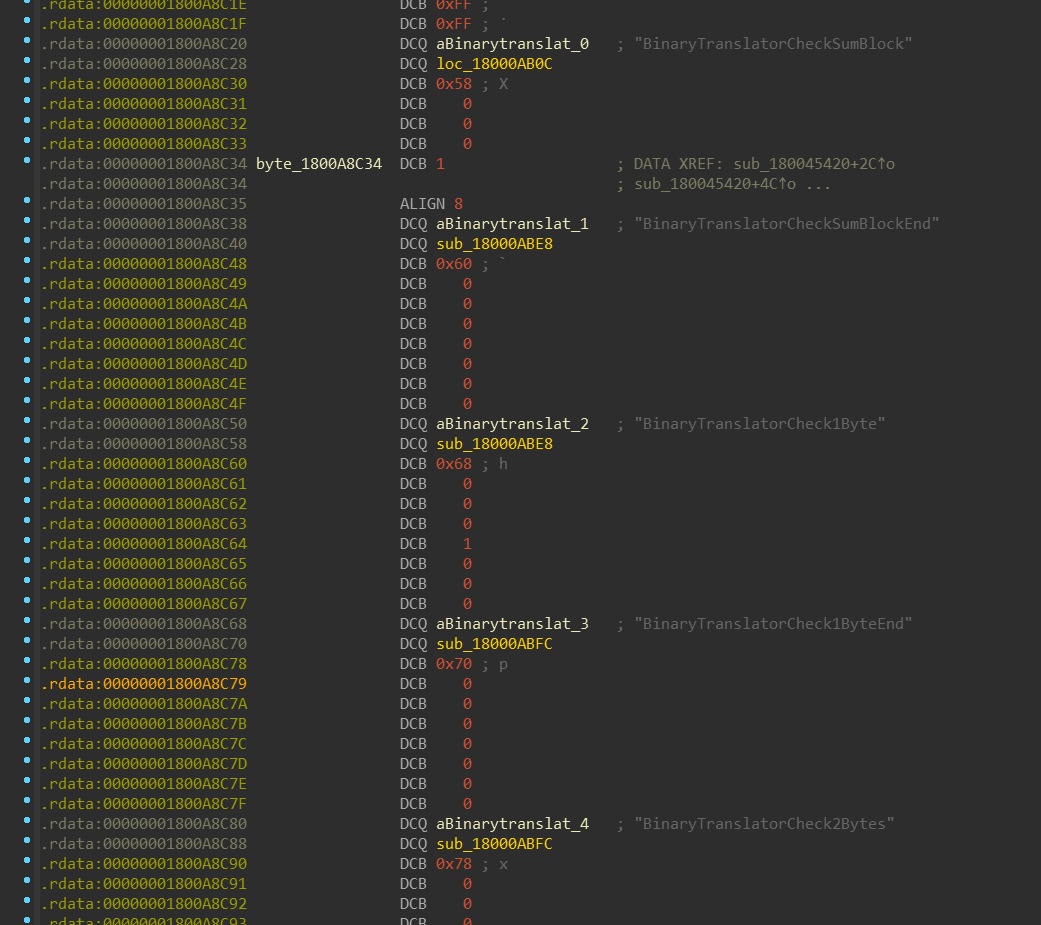
With a simple Python script, we can mass-rename all functions referenced in
this array:
I’d like to thank Milan Boháček for providing me this script.
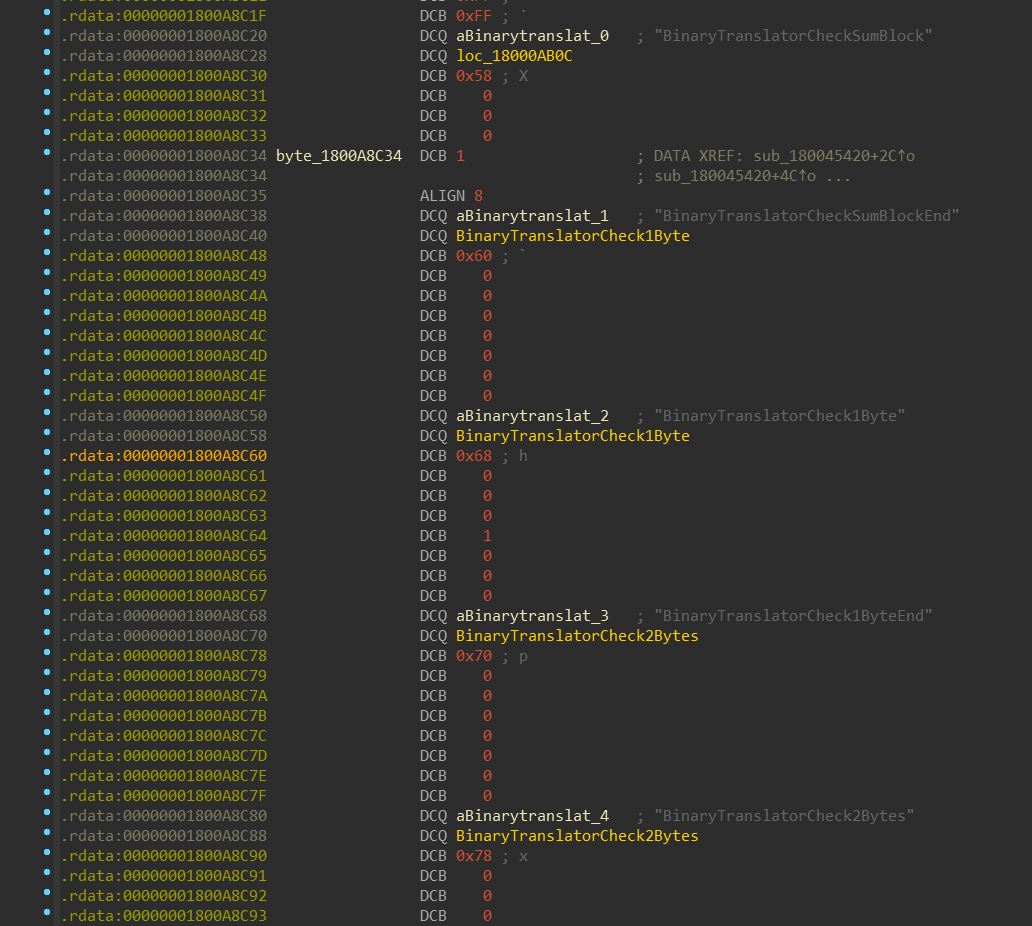
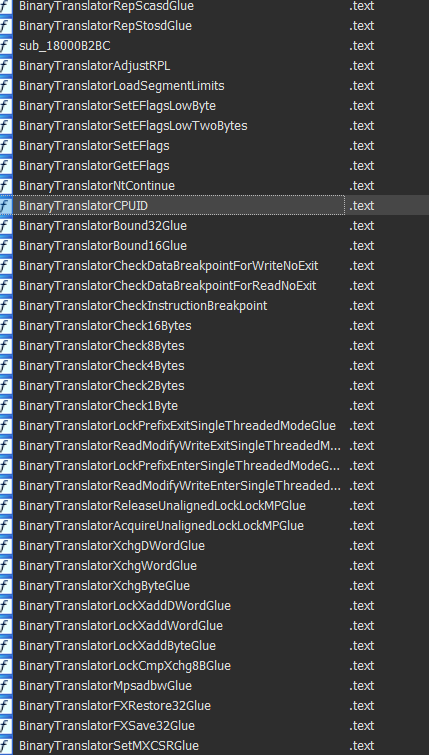
Windows\SyCHPE32 & Windows\SysWOW64
One thing you can observe on ARM64 is that it contains two folders used for x86
emulation. The difference between them is that SyCHPE32 contains small subset
of DLLs that are frequently used by applications, while contents of the SysWOW64
folder is quite identical with the content of this folder on Windows x64.
The CHPE DLLs are not pure-x86 DLLs and not even pure-ARM64 DLLs. They are
“compiled-hybrid-PE”s. What does it mean? Let’s see:
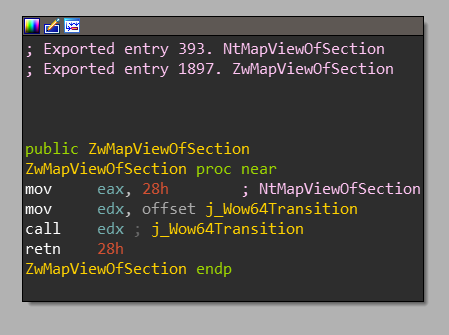
After opening SyCHPE32\ntdll.dll, IDA will first tell us — unsurprisingly —
that it cannot download PDB for this DLL. After looking at randomly chosen Nt*
function, we can see that it doesn’t differ from what we would see in the
SysWOW64\ntdll.dll. Let’s look at some non-Nt* function:
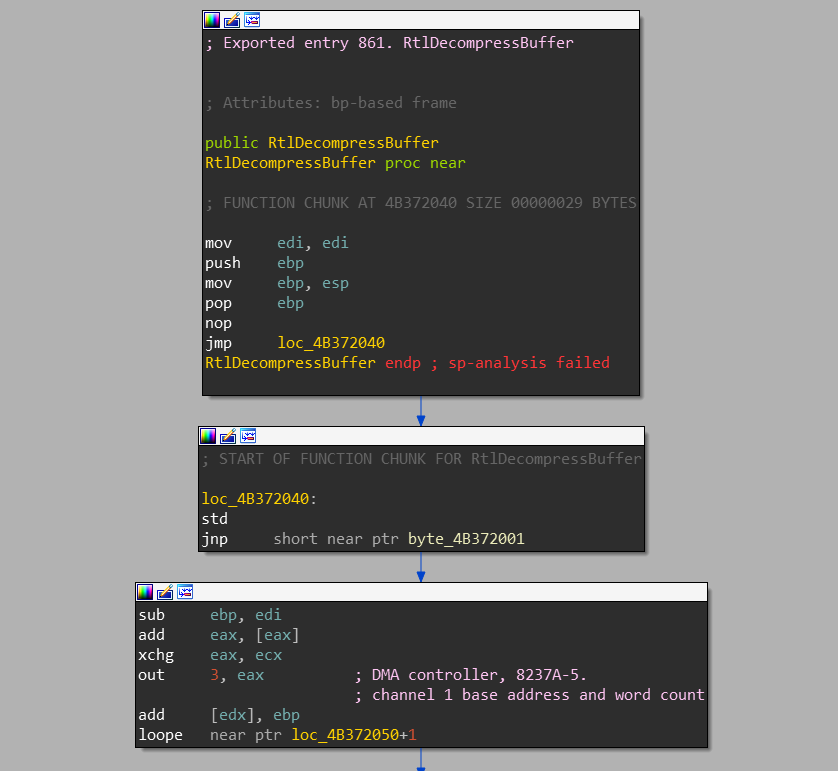
We can see it contains regular x86 function prologue, immediately followed by
x86 function epilogue and then jump somewhere, where it looks like that there’s
just garbage. That “garbage” is actually ARM64 code of that function.
My guess is that the reason for this prologue is probably compatibility with
applications that check whether some particular functions are hooked or not —
by checking if the first bytes of the function contain real x86 prologue.
NOTE: Again, if you’re feeling adventurous, you can patch
FileHeader.Machine
field in the PE header toIMAGE_FILE_MACHINE_ARM64 (0xAA64)and open this
file in IDA. You will see a whole lot of correctly resolved ARM64 functions.
Again, I’d like to thank to Milan Boháček for this tip.
If your question is “how are these images generated?”, I would answer that I don’t know,
but my bet would be on some internal version of Microsoft’s C++ compiler toolchain. This idea
appears to be supported by various occurences of the CHPE keyword in the ChakraCore codebase.
ARM32 on ARM64
The loop inside of the wowarmhw!BTCpuSimulate is fairly simple compared to
wow64cpu.dll loop:
CpupSwitchTo32Bit does nothing else than saving the whole CONTEXT, performing SVC 0xFFFF
instruction and then restoring the CONTEXT.
nt!KiEnter32BitMode / SVC 0xFFFF
I won’t be explaining here how system call dispatching works in the ntoskrnl.exe —
Bruce Dang already did an excellent job doing it.
This section is a follow up on his article, though.
SVC instruction is sort-of equivalent of SYSCALL instruction on ARM64 — it
basically enters the kernel mode. But there is a small difference between SYSCALL
and SVC: while on Windows x64 the system call number is moved into
the eax register, on ARM64 the system call number can be encoded directly
into the SVC instruction.

Let’s peek for a moment into the kernel to see how is this SVC instruction handled:
nt!KiUserExceptionHandlernt!KiEnter32BitMode
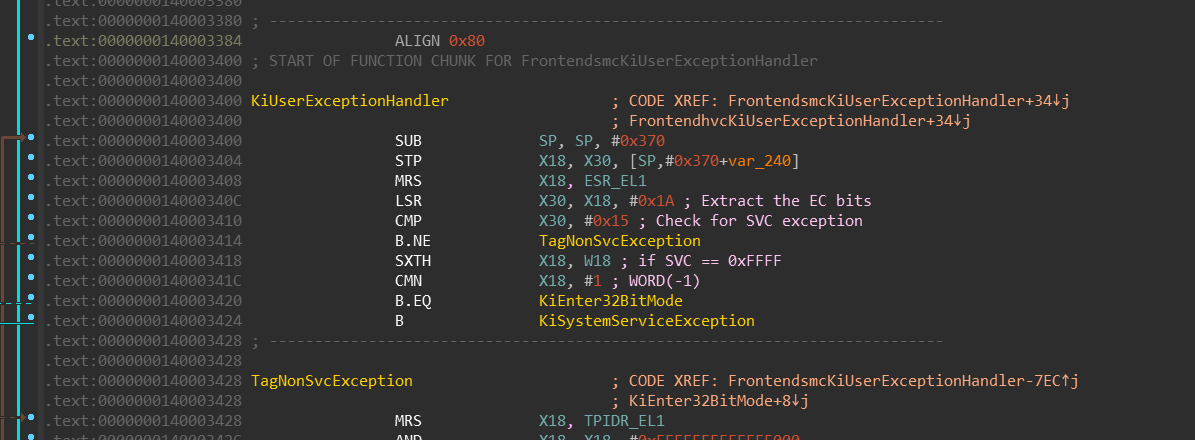
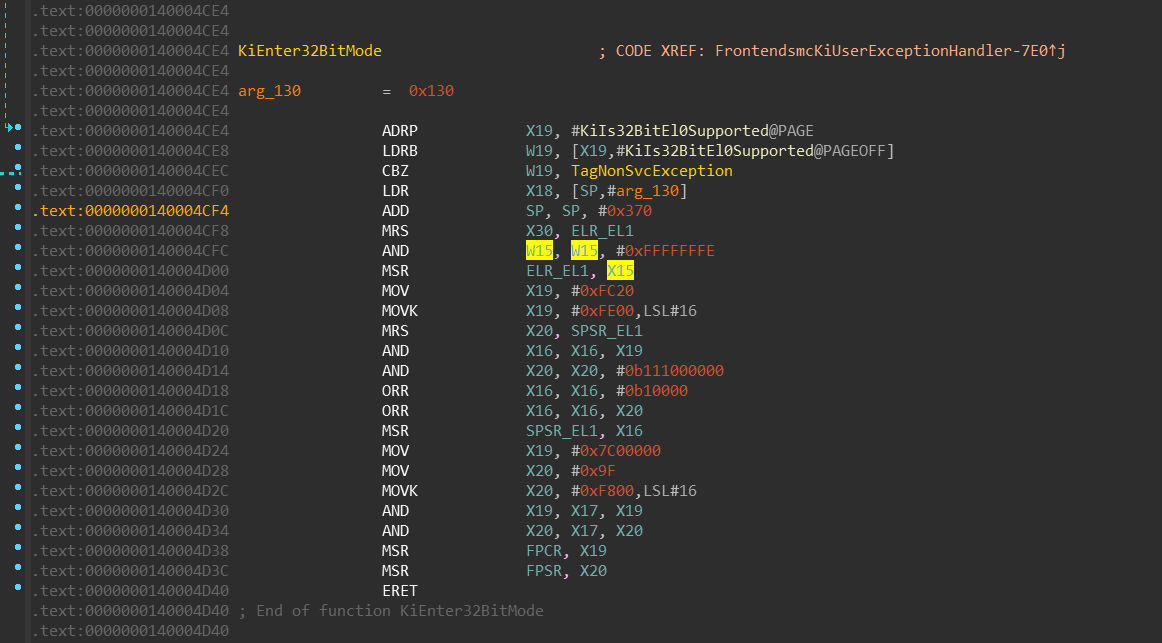
We can see that:
MRS X30, ELR_EL1— current interrupt-return address (stored inELR_EL1system
register) will be moved to the registerX30(link register —LR).MSR ELR_EL1, X15— the interrupt-return address will be replaced by value
in the registerX15(which is aliased to the instruction pointer register —
PC— in the 32-bit mode).ORR X16, X16, #0b10000— bit [4] is being set inX16which is later moved
to theSPSR_EL1register. Setting this bit switches the execution mode to
32-bits.
Simply said, in the X15 register, there is an address that will be
executed once we leave the kernel-mode and enter the user-mode — which happens
with the ERET instruction at the end.
nt!KiExit32BitMode / UND #0xF8
Alright, we’re in the 32-bit ARM mode now, how exactly do we leave? Windows
solves this transition via UND instruction — which is similar to the UD2
instruction on the Intel CPUs. If you’re not familiar with it, you just
need to know that it is instruction that basically guarantees that it’ll
throw “invalid instruction” exception which can OS kernel handle. It is defined-“undefined instruction”.
Again there is the same difference between the UND and UD2 instruction in
that the ARM can have any 1-byte immediate value encoded directly in the
instruction.
Let’s look at the NtMapViewOfSection system call in the SysArm32\ntdll.dll:

Let’s peek into the kernel again:
nt!KiUser32ExceptionHandlernt!KiFetchOpcodeAndEmulatent!KiExit32BitMode

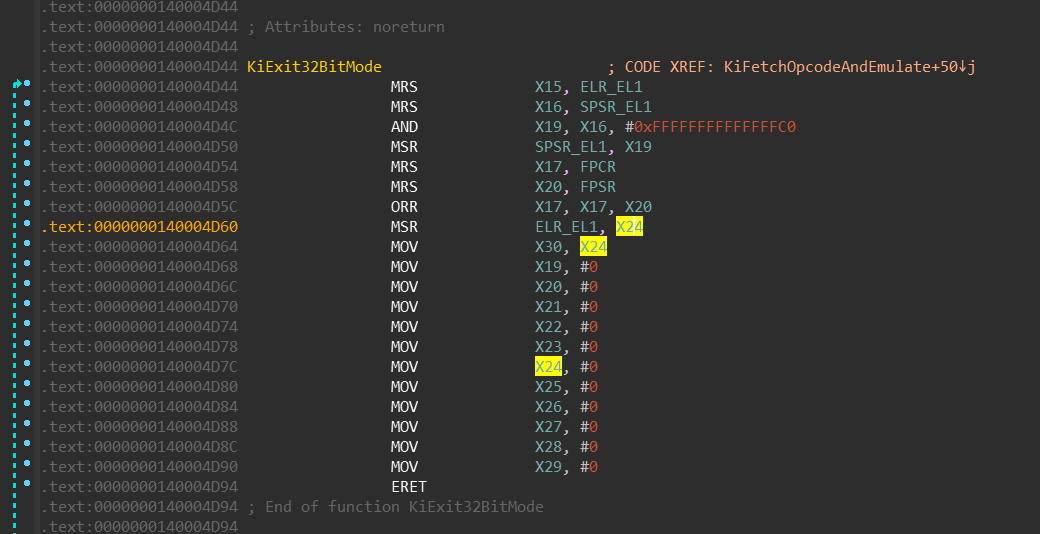
Keep in mind that meanwhile the 32-bit code is running, it cannot modify the value of the
previously stored X30 register — it is not visible in 32-bit mode. It stays there the
whole time. Upon UND #0xF8 execution, following happens:
- the
KiFetchOpcodeAndEmulatefunction moves value ofX30intoX24register
(not shown on the screenshot). AND X19, X16, #0xFFFFFFFFFFFFFFC0— bit [4] (among others) is being cleared
in theX19register, which is later moved to theSPSR_EL1register.
Clearing this bit switches the execution mode back to 64-bits.KiExit32BitModethen moves the value ofX24register into theELR_EL1register. That means when
this function finishes its execution, theERETbrings us back to the 64bit code,
right after theSVC 0xFFFFinstruction.
NOTE: It can be noticed that Windows uses
UNDinstruction for several
purposes. Common example might also beUND #0xFEwhich is used as a breakpoint
instruction (equivalent of__debugbreak()/int3)
As you could spot, 3 kernel transitions are required for emulation of the
system call (SVC 0xFFFF, system call itself, UND 0xF8). This is because on
ARM there doesn’t exist a way how to switch between 32-bit and 64-bit mode only
in user-mode.
If you’re looking for “ARM Heaven’s Gate” — this is it. Put whatever function
address you like into the X15 register and execute SVC 0xFFFF.
Next instruction will be executed in the 32-bit ARM mode, starting with that
address. When you feel you’d like to come back into 64-bit mode, simply
execute UND #0xF8 and your execution will continue with the next instruction
after the SVC 0xFFFF.
Appendix
References
How does one retrieve the 32-bit context of a Wow64 program from a 64-bit process on Windows Server 2003 x64?
http://www.nynaeve.net/?p=191
Mixing x86 with x64 code
http://blog.rewolf.pl/blog/?p=102
Windows 10 on ARM
https://channel9.msdn.com/Events/Build/2017/P4171
Knockin’ on Heaven’s Gate – Dynamic Processor Mode Switching
http://rce.co/knockin-on-heavens-gate-dynamic-processor-mode-switching/
Closing “Heaven’s Gate”
http://www.alex-ionescu.com/?p=300
